Kenya: Maasai Mara Migration Special Tour Report 2022
5 December 2022


















































































































A perfect Serval portrait in nice late afternoon light (image by Mike Watson)

These young guys were part of a threesome of subadult males (image by Mike Watson)

Entim Crossing on the Mara River but minus any traffic this visit (image by Mike Watson)

Servals typically spend a lot of time sitting, using those massive ears and sharp eyes in search of prey (image by Mike Watson)

Photographing Servals in the long grass of the Mara is a real challenge, so many grass stems! (image by Mike Watson)

Pre-sunrise blue hour Giraffe (image by Mike Watson)

One of the two remaining males of the famous Tano Bora coalition (the ‘first five’) at a scenting tree late in the afternoon (image by Mike Watson)

This was the biggest and baddest male Leopard we saw, he held a territory on the west bank of the river, where he had just killed a young zebra (image by Mike Watson)

Feeling the full force of a storm on the Maasai Mara (image by Mike Watson)

The gorgeous Serval has unfeasibly long legs (image by Mike Watson)

Three in a row, Rüppell’s, Lappet-faced and White-backed Vultures (image by Mike Watson)

I could tell it was going to be a bad day’ said the wildebeest. It eventually succumbed but not after it put up a 50 minute fight until a second croc joined in and drowned it (image by Mike Watson)

Members of the Topi pride keep watch at sunset (image by Mike Watson)

Woodland Kingfisher in the grounds of the camp at Entim (image by Mike Watson)

A beautiful soft sunset on the Mara (image by Mike Watson)

Coke’s is the Hartebeest of the Mara, named after the heart-shaped horns (image by Mike Watson)

Spotted Hyaena family at the entrance to their den on the Mara (image by Mike Watson)


Yellow-throated Sandgrouse male (image by Mike Watson)

This crusty old bull Elephant was quite friendly it’s good to have local Maasai driver guides who know their temperament! (image by Mike Watson)

Wildebeest look much more scary than an animals, which is effectively the Mara Mars Bar for most predators (image by Mike Watson)

Elephant in the evening blue hour (image by Mike Watson)

An audience with a Serval is high on the wish list of visitors to the Mara. We were lucky to have two this time (image by Mike Watson)

Cape Buffalo. Absolute unit! (image by Mike Watson)

The Mara has at least one million lone trees suitable for sunsets (image by Mike Watson)
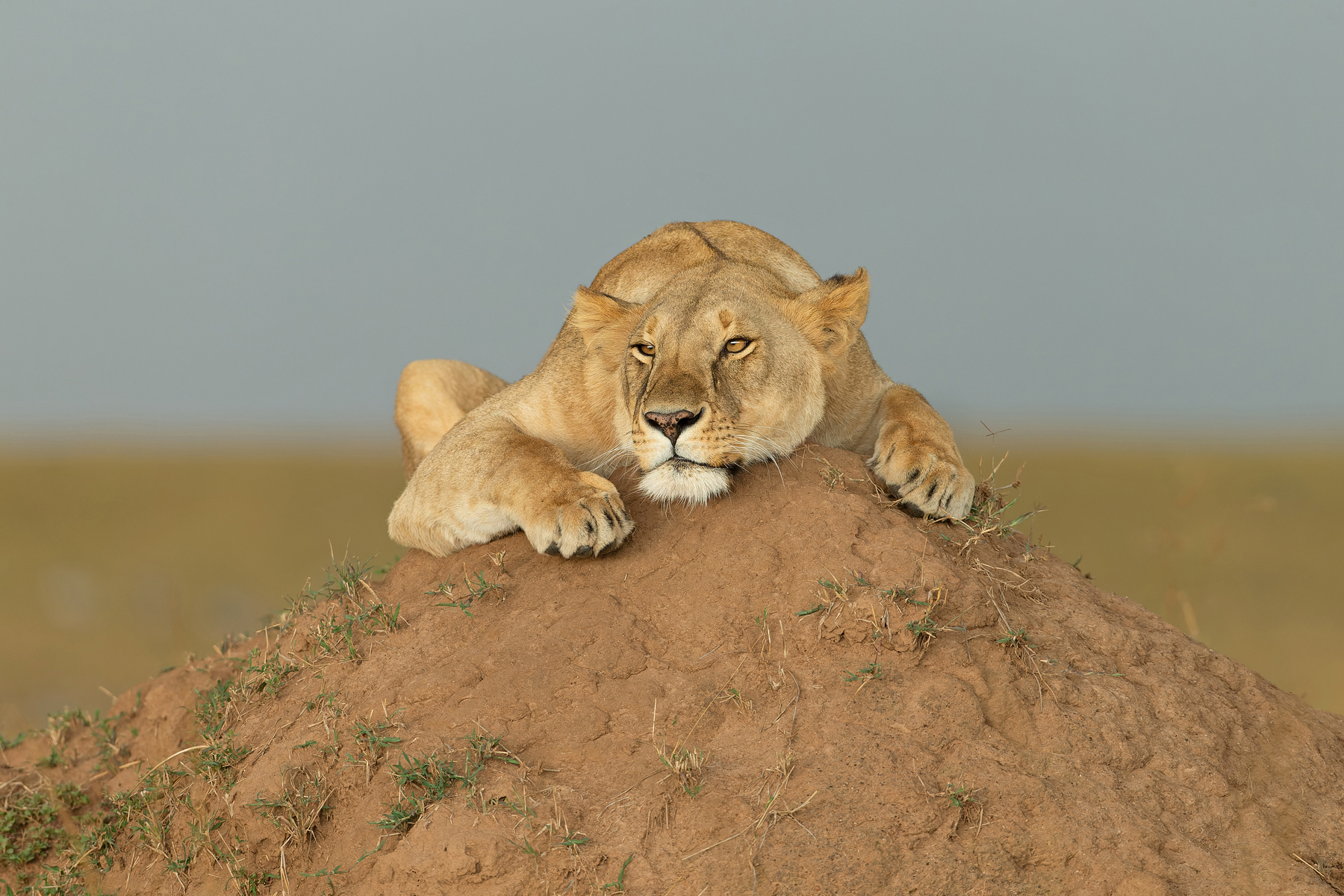
A lioness watches the sunset, with a storm rapidly approaching. Within minutes the rain was lashing down (image by Mike Watson)

Another dinosaur of the Mara, the awesome Secretarybird (image by Mike Watson)

Our first Cheetah was an audience with Nashipai was in the shade of a bush early one morning (image by Mike Watson)

Mother Spotted Hyaena near its den (image by Mike Watson)

The tiny, yet busy airstrip at Olkiombo, the gateway to the Mara for many ecotourist visitors (image by Mike Watson)

There was almost a zebra crossing by they were put off by the obnoxious hippos (image by Mike Watson)

Angry hippo rounds on the Topi pride of lions who had cornered it in a small water hole on the plains near Rhino Ridge (image by Mike Watson)

Nashipai about to pick up the pace, Cheetahs certainly look like the fastest land animals! (image by Mike Watson)

The males of the Mara are known for their impressive manes (image by Mike Watson)

A fine Black-bellied Bustard in the endless sea of grass that is the Maasai Mara (image by Mike Watson)

At last a crossing! Wildebeest heading across the Sand River into Kenya from Tanzania, passports ready! (image by Mike Watson)

A dominant male Spotted Hyaena stands guard over a wildebeest carcass, it’s all about looking menacing (image by Mike Watson)

Baby Plains Zebras are incredibly cute (image by Mike Watson)

Lion, a male named Lokulup having a bad hair day (image by Mike Watson)

Astonishingly close early morning Lioness from the car window (image by Mike Watson)

Abyssinian Ground Hornbill, a living dinosaur, strides across the Maasai Mara Grassland (image by Mike Watson)

A hippo chews on a dead young wildebeest in the Mara river. We don’t know if it killed the animal nor whether or not it was eating it but it was a first for our very experienced guides (image by Mike Watson)

A female Ostrich on Pose Plains, Maasai Mara (image by Mike Watson)

This tree near Entim Camp looking out over the Mara River valley was a Lappet-faced Vulture’s favourite perch (image by Mike Watson)

Cheetah hunting. Lovely Nashipai (image by Mike Watson)

Relaxing in the lounge at Entim Camp (image by Mike Watson)

We were thrilled to catch up with one of only 40 Black Rhinos in the Mara. They are shy and mostly keep within impenetrable bush (image by Mike Watson)

Portrait of Lokolup (image by Mike Watson)

Dark skies and sunlight on the Mara (image by Mike Watson)

Abyssinian Ground Hornbill. A locust goes down the hatch (image by Mike Watson)

Storm clouds building on Pose Plains, Maasai Mara (image by Mike Watson)

Sky on fire! Probably the most dramatic of the many spectacular sunsets we saw on the Mara (image by Mike Watson)

Lion cub snarl (image by Mike Watson)

Pesky cubs jump on their mother in the Topi pride of the Mara (image by Mike Watson)

The new king of the Mara (image by Mike Watson)

The sun being crushed out of the sky by a leaden blanket of storm clouds (image by Mike Watson)

Hunting Serval on the Maasai Mara (image by Mike Watson)

Elephant herd at the famous Governor’s Camp (image by Mike Watson)

One of the Topi pride, this lioness had attracted a few flies, the scourge of Mara wildlife (image by Mike Watson)

Crocodiles often bite the back legs of wildebeest, probably a lower risk area than near the horns (image by Mike Watson)

Serval on the prowl on the Maasai Mara (image by Mike Watson)

Young Lions making their way across the grassland, from the shade of one to bush to another (image by Mike Watson)

White-bellied Bustard is common in the grassland of the Maasai Mara (image by Mike Watson)

Supermodel Cheetah Nashipai, surely the most elegant of all cats (image by Mike Watson)

Cheetahs have non-retractable claws as seen in this image (image by Mike Watson)

The bustards of the Mara are generally quite tame, look how close this Black-bellied is as it saunters between our Land Cruisers (image by Mike Watson)

Maasai Giraffes at Governor’s Camp, always looking surreal (image by Mike Watson)

Wildebeest and zebra numbers gradually build on the banks of the Sand River in the southern Mara (image by Mike Watson)

The Serval’s leap! (image by Mike Watson)

Little Bee-eater – a jewel of the Mara (image by Mike Watson)

The seldom seen African Marsh Owl is present on the Maasai Mara in small numbers (image by Mike Watson)

Stunning Leopardess Luluka wanders past our vehicle on the Mara (image by Mike Watson)

One of the big, bad male Leopards crossing open grassland near Lookout Crossing (image by Mike Watson)

Saddle-billed Stork pair at Governor’s Camp, a truly impressive bird! (image by Mike Watson)

Another encounter with the lovely Luluka, we did not know it at the time but she was pregnant (image by Mike Watson)

Cavendish’s Dik Dik – one of four sightings on this tour (image by Mike Watson)

Plains Zebras grazing quietly, the nearest lions must be at least a kilometre away! (image by Mike Watson)

Forever in blue jeans! Topi on the lookout (image by Mike Watson)

There’s not too much colour to a Cape Buffalo so they make good b&w subjects (image by Mike Watson)

Golden hour Elephant (image by Mike Watson)

Black-winged Lapwing, another smart lapwing that graces the Mara (image by Mike Watson)

The super-smart Spur-winged Lapwing. There was no end of smart lapwings on the Mara (image by Mike Watson)

A bachelor group of Lions huddle together in whatever shade they can find in the heat of the day (image by Mike Watson)

Watching Lions, watching another storm approaching (image by Mike Watson)

Close encounter with a massive male Ostrich (image by Mike Watson)

An impressive Defassa Waterbuck on the Mara near Entim Camp (image by Mike Watson)

Marabou Storks are dominant at the carcases, my, you is ugly! near Entim Camp (image by Mike Watson)

African Wattled Lapwing, one of several lapwing species living in the Mara (image by Mike Watson)

A sleepy lioness awakes at sunrise, unware that a balloon trip picnic team had set up less than 100m away while she slept in the long grass (image by Mike Watson)

Elephant, sunset god light, a photographer’s dream (image by Mike Watson)

Rufous-bellied Heron, present in small numbers at the rapidly drying marshes (image by Mike Watson)

Stately Elands in the Mara landscape (image by Mike Watson)

Wild Images guest Howard photographs a stretch of the Sand River, looking towards Tanzania (image by Mike Watson)

This encounter was much more pleasant before everyone else turned up. After catching her own breath, Nashipai drags the Impala under a bush to eat it. We pushed off after this having already spent a couple of hours with Nashipai (image by Mike Watson)

Another bush breakfast stop on the Mara, we enjoyed a different spot each day (image by Mike Watson)

It is difficult to understand how such a delicate predator as the Serval can survive in such a dangerous place as the Maasai Mara (image by Mike Watson)

Plains Zebra sunset (image by Mike Watson)

Cheetahs spend a lot of time gazing far into the distance for prey and/or danger, the tear stains below their eyes helps them to cope with glare and sharpens their eyesight (image by Mike Watson)

Maasai Mara sunset (image by Mike Watson)

Yellow-throated Sandgrouse pair (image by Mike Watson)

A rather scruffy-looking Secretarybird on the Mara (image by Mike Watson)

Portrait of a pretty Yellow-throated Sandgrouse female (image by Mike Watson)

There is always something to put in front of the sunset on the Mara (image by Mike Watson)

Some of our folks could not bear to watch this poor wounded zebra being eaten alive by hyaenas, a few hours later it was just a pile of bones (image by Mike Watson)

A trip of 25 Caspian Plovers, fresh from their breeding grounds on the Central Asian steppes, was already on the Mara by 25 August! (image by Mike Watson)

A young Martial Eagle patrolling the banks of the Mara River (image by Mike Watson)

The beautiful Grant’s Gazelle is present in very small numbers on the Mara (image by Mike Watson)

There can be fewer finer sights on the Mara than a male lion (image by Mike Watson)

Nicely backlit young male Lion in evening sun (image by Mike Watson)

Misty Mara. Early in the morning before the balloons had taken flight (image by Mike Watson)

We were lucky to have two Spotted Hyaena dens occupied during our stay, mum nursing here (image by Mike Watson)
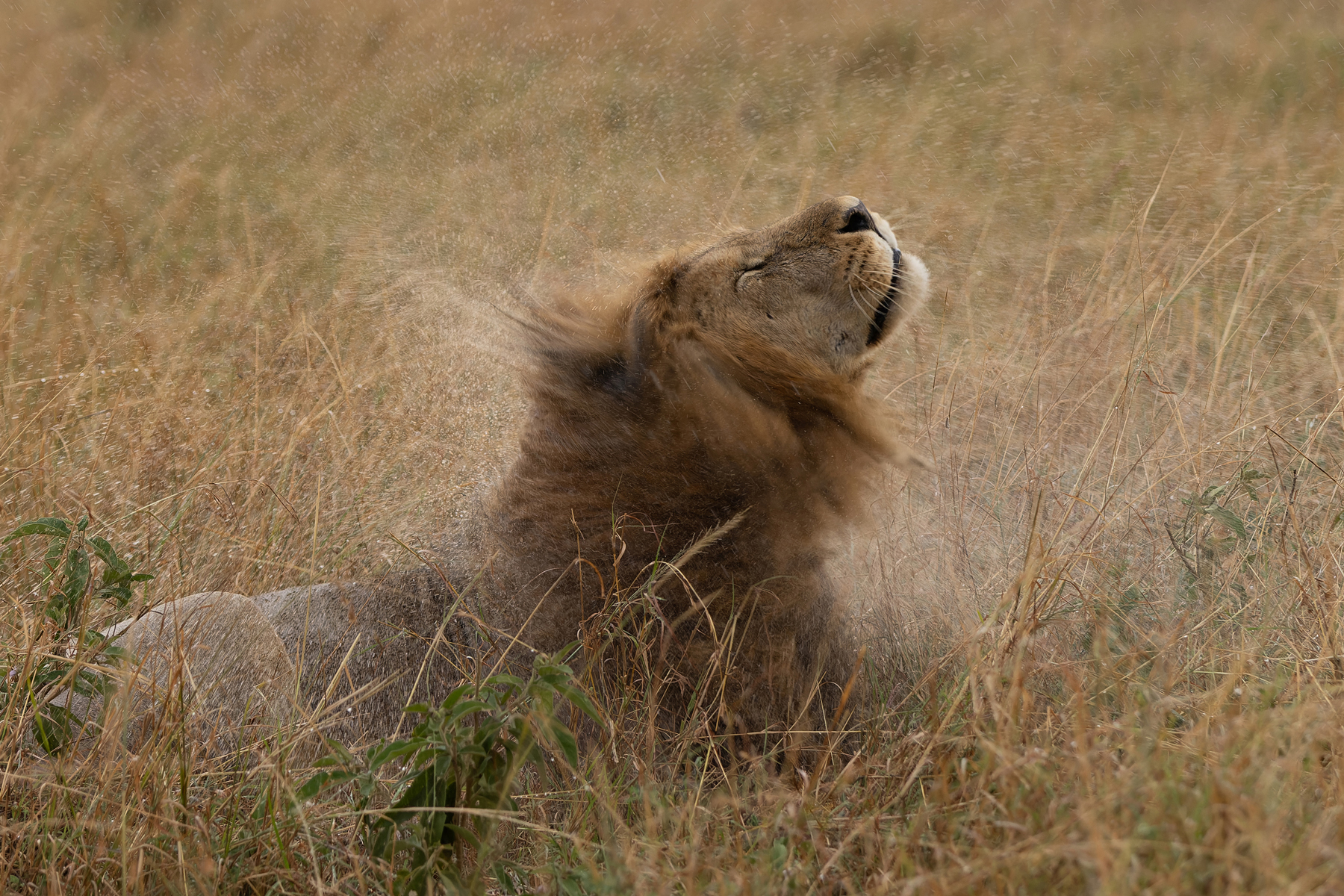
This male Lion is called Mrefu, a son of the famous Scarface. What to do in the rain? Wait for a head shake! (image by Mike Watson)
I’ll get this out of the way before I talk about anything else. Although there was plenty of migration in evidence on the 2022 Wild Images Kenya: Maasai Migration Special tour, we weren’t lucky in seeing a deep-water river crossing. Our 2020 tour experienced numerous deep-water crossings, starting on their first afternoon but the animals’ movements this time did not present us with one. We did see one crossing, albeit only ankle deep and of the shallow Sand River, a tributary of the mighty Mara River and we also saw some gruesome crocodile and hippo action. That said we still had a jaw-droppingly good visit to one of (if not the) world’s best wildlife destinations! The number and array of megafauna is such that there is always something thrilling happening, even if it was not deep-water crossings!
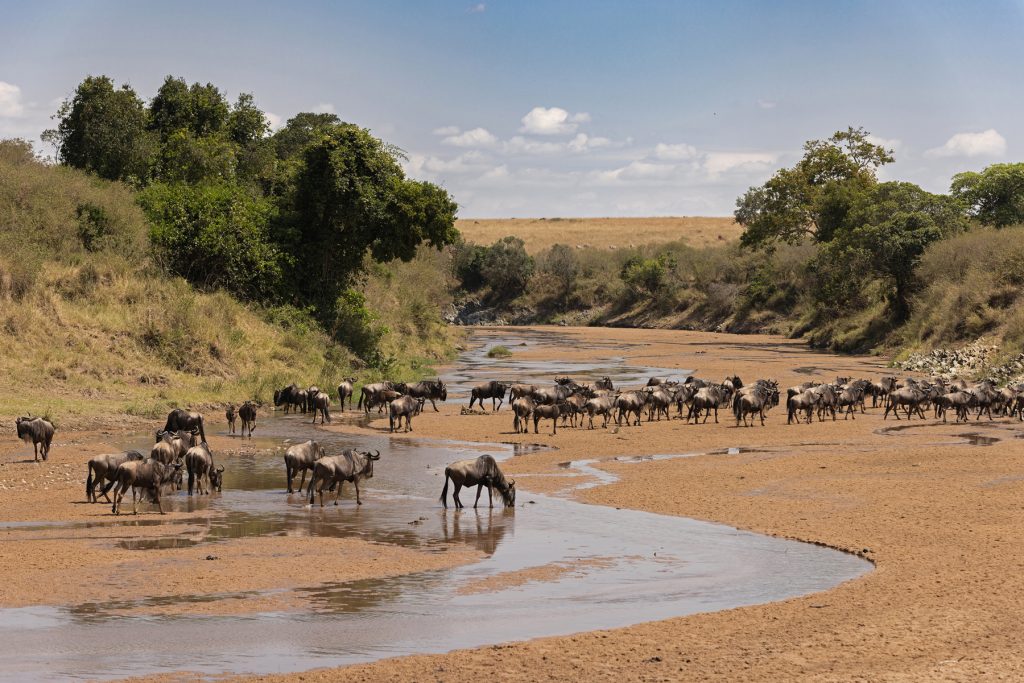
At last a crossing! Wildebeest heading across the Sand River into Kenya from Tanzania, passports ready! (image by Mike Watson)
The African safari big 5 are all on the Mara (Mara means ‘spotted’ referring to the bushes and trees dotted across the grassland landscape). Lion, Leopard, Elephant, Buffalo and Rhino (Black in this case) were considered to be the most prized hunting trophies, hence ‘Big 5’. It is a shame that this term is still used, as Cheetah is surely worth a place at the top table, maybe at the expense of the cow relative? Staying at a single location for the whole of our stay was a massive plus, so rarely do we do anything like this on our tours, which are usually road trips sometimes with a few internal flights included.
We all took many thousands of images and our top 10 outstanding highlights were probably: Cheetah (beautiful Nashipai and the two surviving males of the Tano Bora); Serval (two encounters); Lions (a total of 98 encounters but particularly the dramatic hippo-hunting encounter); Leopard (7 encounters including two with beautiful the female Luluka); Stormy sunset landscapes; Spotted Hyaena females with pups; the Sand River wildebeest crossing; Black Rhino (one of only 40 left on the Mara); Southern Ground Hornbill and Secretarybirds hunting in the grass. Bird and mammal encounters were even judging from our other highlights. Photogenic mammals included Elephants, the gorgeous Grant’s Gazelle, Coke’s Hartebeest, Eland, Hippo, Grant’s (or Plains) Zebra, Maasai Giraffe, African Buffalo, Defassa Waterbuck and the diminutive Cavendish’s Dik-dik while the best other birds were probably Ostrich, White-bellied and Black-bellied Bustards, Lappet-faced Vulture, Marabou, Martial Eagle, Bateleur, Yellow-throated Sandgrouse, Rufous-bellied Heron, Little Bee-eater, Woodland Kingfisher and the various lapwings we saw every day. Mind you that is a birder’s view so there would probably be votes for less significant but more flashy commoner species from others!
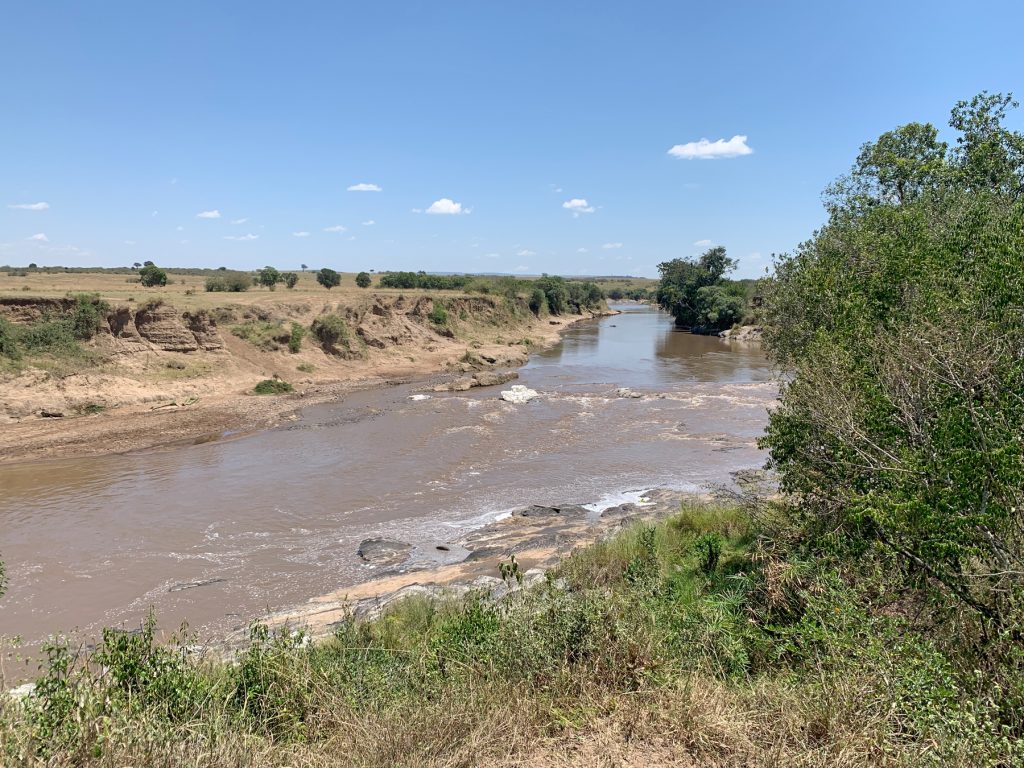
Entim Crossing on the Mara River but minus any traffic this visit (image by Mike Watson)
It is not often that you stay somewhere that delivers on every excursion, with such a variety of different subjects and added to that the camp we stay at, Entim Camp, located right on the bank of the Mara River, commanding a superlative view over one of the main crossing points is an experience. It is a luxury tented camp and although the tents are not permanent structures, for the intent of our stay they might as well be. They are spacious, fitted with nice furniture, ensuite bathroom/shower (soap, shampoo and conditioner all provided!), electricity points and a daily laundry service. The animals of the Mara can roam freely through the camp but they tend to avoid the bright lights of the restaurant/lounge area and the pathways to the tents while they are people coming and going. During the night, the awesome Maasai camp guards, who keep us safe, let them roam more freely. The hippos that spend the daytime in the Mara River below, like to munch the green grass of the camp’s grounds, hyaenas can be heard regularly ‘whooping’ after dark and on some nights Lion and Leopard could be heard calling. The former sometimes a little too close to allow deep sleep, although they are so loud, they always sound closer than they actually are!
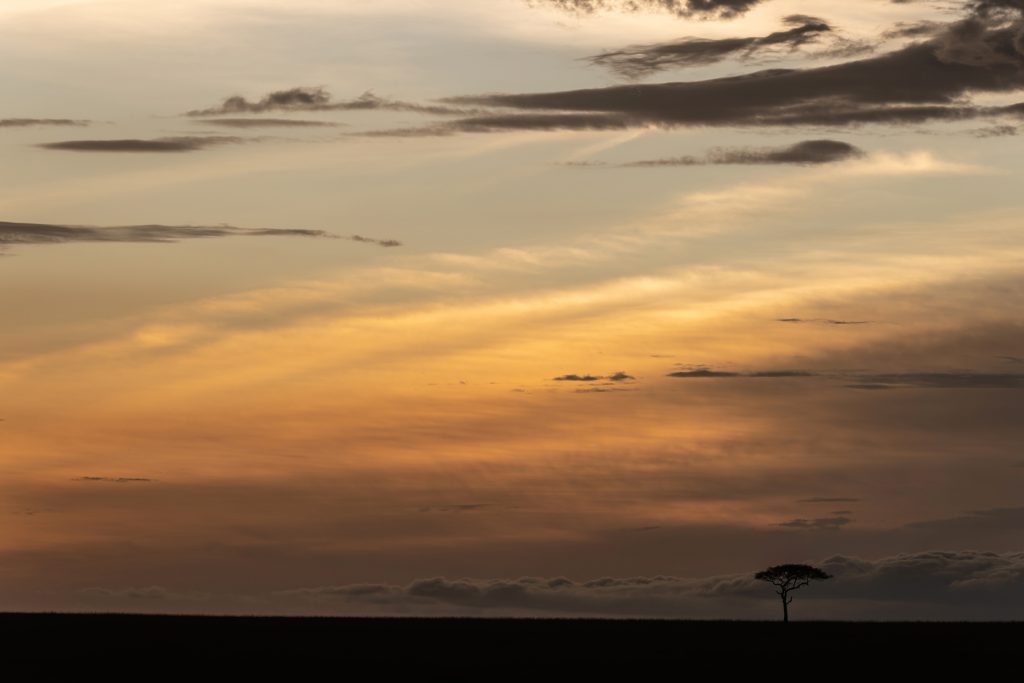
A beautiful soft sunset on the Mara (image by Mike Watson)
The food at Entim Camp was out of this world and the staff were incredibly attentive and helpful. Nothing was ever too much trouble! All of this is very well, and you could rightly expect this level of service in a luxury hotel, but I had to remind myself that we are miles from anywhere in the remote bush. How is it possible to produce such a standard of meals somewhere like this? Then there were our amazing, customised vehicles. We were split into two safari vehicles. Long wheelbase Toyota Landcruisers that coped very well with the often-tricky terrain, particularly after rain or at rocky river crossings, while providing excellent all-round visibility for photography without windows but also with roof hatches. Our Maasai driver guides were the key to a successful visit. They were both incredibly skilful and had an eye for photographic composition as well, having guided very many photographic groups in the past. Not often is your driver thinking about how to line up a subject against a background as he manoeuvres his vehicle elsewhere, or which lighting angle is going to work best. They even know you sometimes want against the light conditions instead of with it! Wherever you are towards the end of the day, there is usually a sunset landscape spot at hand too. They were very impressive. OK there were a couple of minor mishaps along the way but generally their vehicle positioning was flawless and way better than any of us could ever manage! Staying at Entim puts us right in the middle of the core zone of the Mara, without the need for long each way transfers or a race to be at the park gates by 6.30PM.
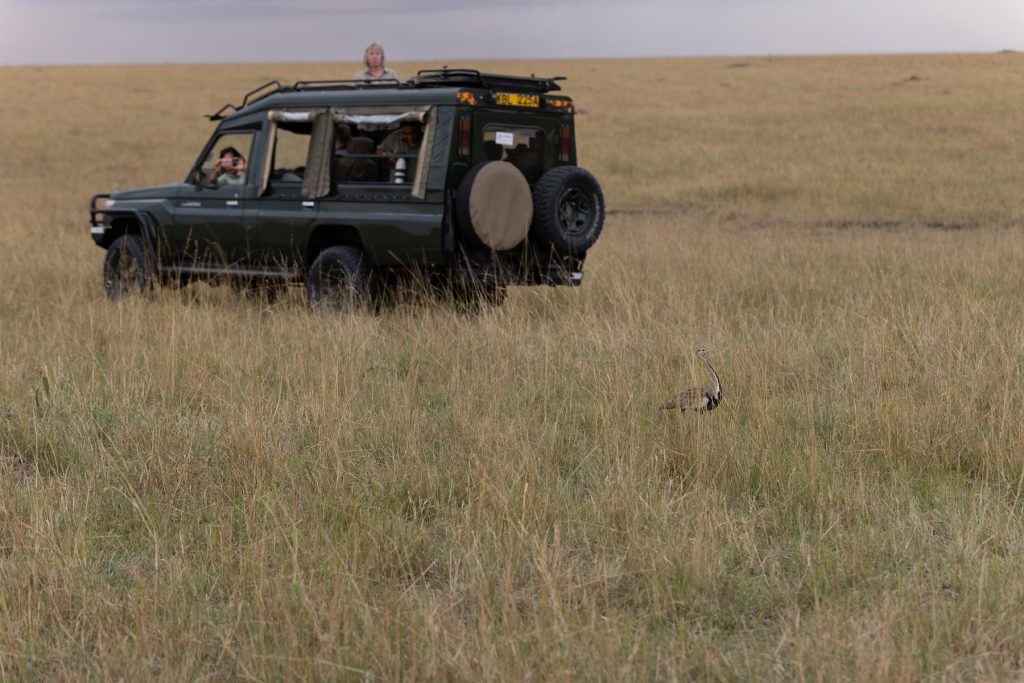
The bustards of the Mara are generally quite tame, look how close this Black-bellied is as it saunters between our Land Cruisers (image by Mike Watson)
The Maasai Mara is contiguous with the Tanzania’s Serengeti to the south and was declared a nature reserve in 1961 when 1,800 thousand square kilometres were protected. This shrank in the 1980s when a substantial part of the Mara was given back to local communities to operate as concessions and the current area now included in the reserve is around 1,500 square kilometres. The Serengeti is much larger, and the combined ecosystem extends over around 25,000 square kilometres! The Mara River flows through the reserve roughly from north to south and is fed by tributaries including the Talek and Sand Rivers. It is bordered to the west by the East African Rift Escarpment, and it is a high plain, at almost a mile high above sea level. Consequently, it enjoys a pleasant climate, usually no more than 30 degrees Celsius with quite frequent rainstorms at this time of year. From July onwards almost two million herbivores migrate north from the Serengeti in search of fresh grazing – 1.3m wildebeest, 0.5m Thomson’s Gazelles, 100K Topi, 18K Eland and 200K Grant’s (or Plains) Zebras in one of the most incredible wildlife spectacles in the world. However, in recent years climate change and pressure from humans has made the migration more difficult to predict, as with this year, when we ought to have had several deep-water crossings when the animals decide they need to move to the opposite side of the river for better grazing. We could see thousands of the wildebeest to the west of us in the Mara Triangle and stretching towards Tanzania, however, the grass the lines of animals were spread over was very green so no need to come on over to our side right now. We were reassured that no-one else was getting any significant crossings during our stay. The last had been a couple of weeks before we arrived, and I heard that the next were in mid-September. So, now you know, our tour was more a Big Cat Diary than a migration special.
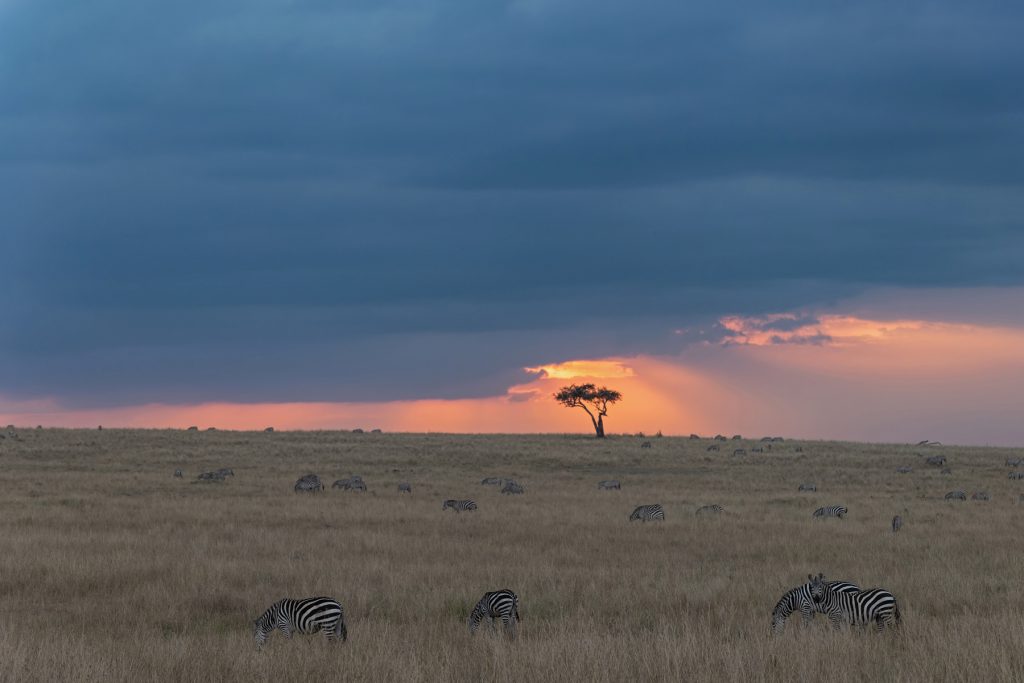
Plains Zebra sunset (image by Mike Watson)
We boarded our Safarilink flight at Nairobi’s tiny Wilson Airport, a little Dash 8. First stop on its bus-like route was Olkiombo Airstrip, where we bounced along and were greeted by our Maasai driver guides. It was surprising how quickly the Mara appeared, although farms and settlements became much fewer, the Mara itself is criss-crossed by zillions of jeep tracks so from the air it is a far less impressive wilderness experience than it is by the time you are immersed in the sea of grass at ground level! The airstrip is not fenced so animals are free to wander near or even across it and our transfer to Entim Camp passed by zebras, giraffes, buffalos, warthogs, Elands, Topi antelopes, Thomson’s Gazelles and Impalas. As soon as you hit the ground, you are in the zone! However, all of these, including a very distant ostrich, were going to be common daily sightings so we did not tarry. Our guides have incredible eyesight and are very well trained at spotting and identifying animals at long range, as well as being hooked up to ‘Radio Mara’, the guides’ CB network, which reports anything of note happening. We heard that a group of four young male lions was nearby, so we called in on them enroute to the camp. Typically, they were not doing anything in the middle of the day, in horrible glary light so we did not stay long. Several Lilac-breasted Rollers and a Grey-headed Kingfisher added splashes of colour to the khaki landscape.
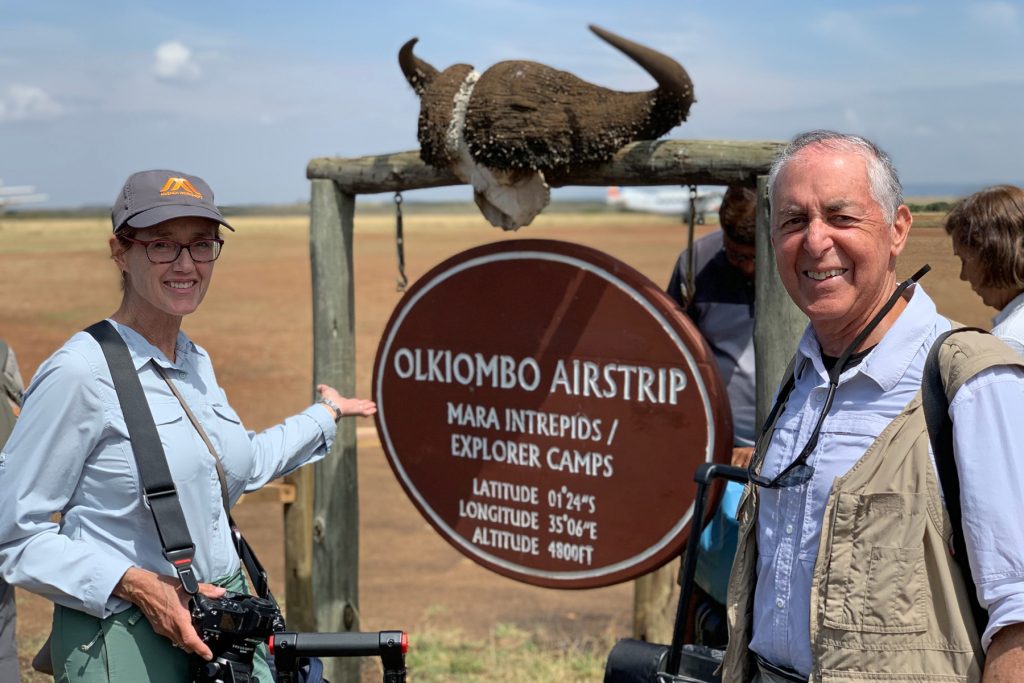
The tiny, yet busy airstrip at Olkiombo, the gateway to the Mara for many ecotourist visitors (image by Mike Watson)
The main wing of the camp, where we were staying, has a terrific lounge and dining area overlooking the river and we could see at least 28 hippos and at least one large Nile Crocodile on our arrival. A Black Rhino had apparently sauntered past the lounge a couple of days previously! After lunch our afternoon drive made a beeline for the same group of young male lions, who had moved from one group of bushes to another and were a little more photographable but still nothing remarkable. We continued onto Pose Plains to the northeast of Entim lining up a female ostrich quite nicely with a dark sky and billowing thunder clouds. Zebras were quite nicely-lit by sun dipping towards the western skyline as was a mother Spotted Hyaena at the entrance to her den, with a couple of tiny smoky hyaena pups by her. Lovely! The best photo opportunities this afternoon were probably a couple of different young male lions, beautifully backlit and then a spectacular sunset, the whole cloudy sky on fire illuminated by the setting sun. A very nice introduction to our time on the Mara, we only had another 19 safaris to go!
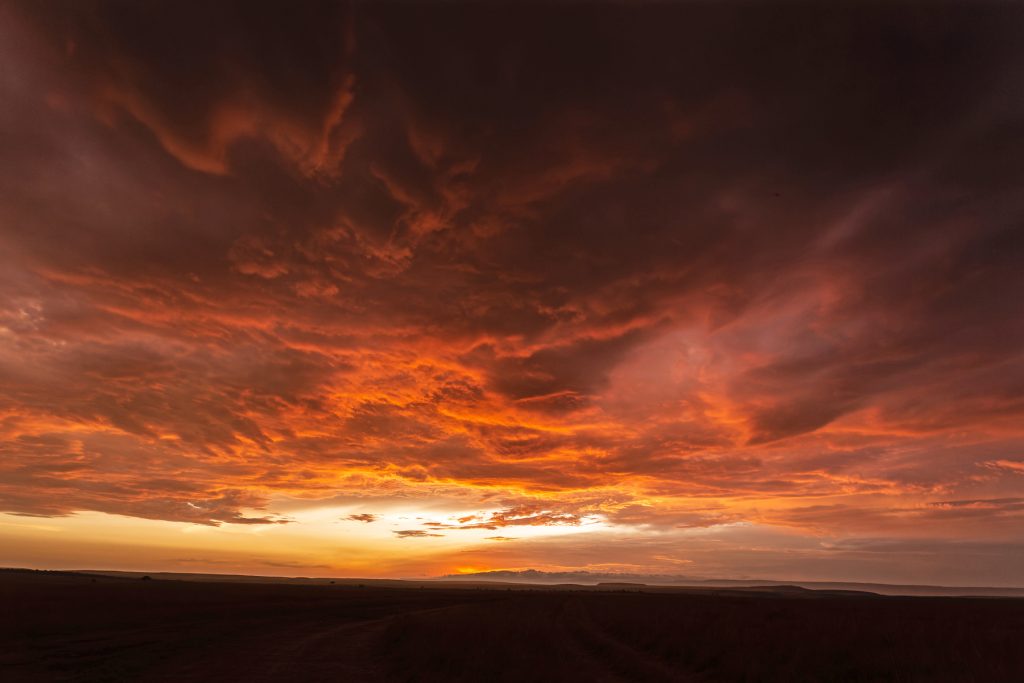
Sky on fire! Probably the most dramatic of the many spectacular sunsets we saw on the Mara (image by Mike Watson)
The 5.30AM coffee delivered to my tent each morning was very welcome and set me up for the safari. We took breakfast with us and ate it in a different, and often very lovely, location every day. We made our way to Olmisingiyioi, on the plains to the east of Entim this morning, in search of Lions, and lion cubs in particular. Our guides knew where there was a pride with some very young cubs and sure enough it was not long before we were watching two tiny cubs, being moved by their mum by the scruff of the neck, in a deep gully choked with bushes. Every now and again the inquisitive little cubs would venture into view, among the morning dew-covered vegetation, pushing back against their mum’s attempts to hide them. We had even more ridiculous close views of mum, walking right past the front of the Landcruiser, only a couple of metres away. The lions’s progress in the gully was marked by waterbirds being flushed out of it – Hadeda Ibis, Striated Heron and Black-crowned Night Heron. Little Bee-eater perched in a nearby bush in the early morning sun. What a great start!
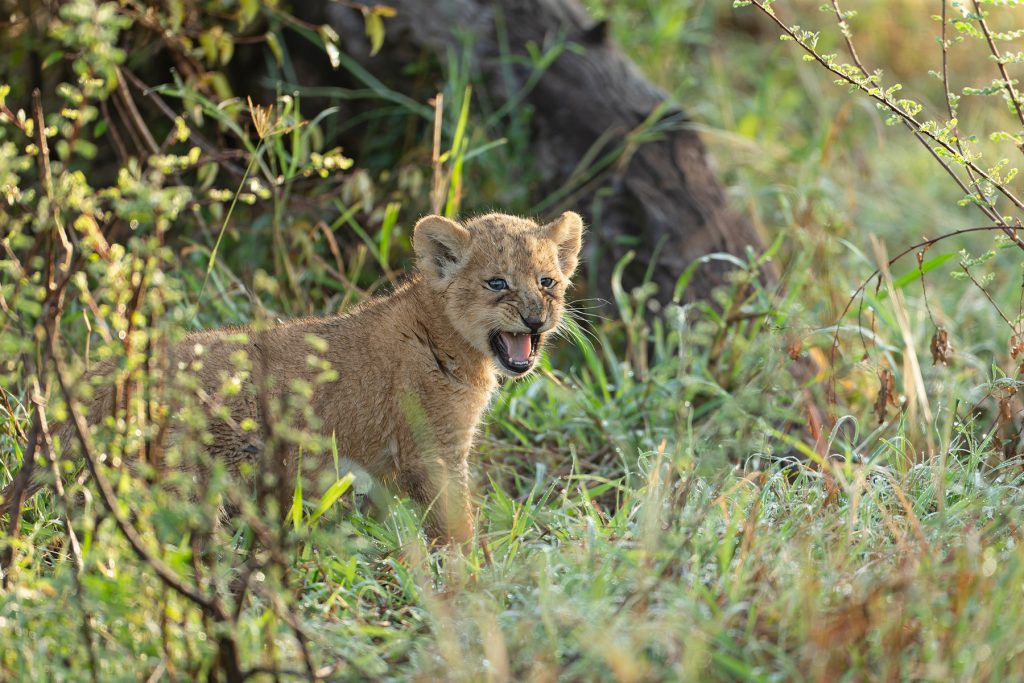
Lion cub snarl (image by Mike Watson)
On our first day of the tour news came over the radio of a Leopard nearby, so off we went. She was the lovely Luluka and we had some nice looks at her as she wandered across the grassland on her way somewhere. Being a lazy cat she liked to walk on the jeep tracks, which didn’t help with backgrounds, either of wheel ruts and/or other vehicles but she was a glorious sight nevertheless in the open at such close range in perfect early morning light. The number of vehicles increased so we left.
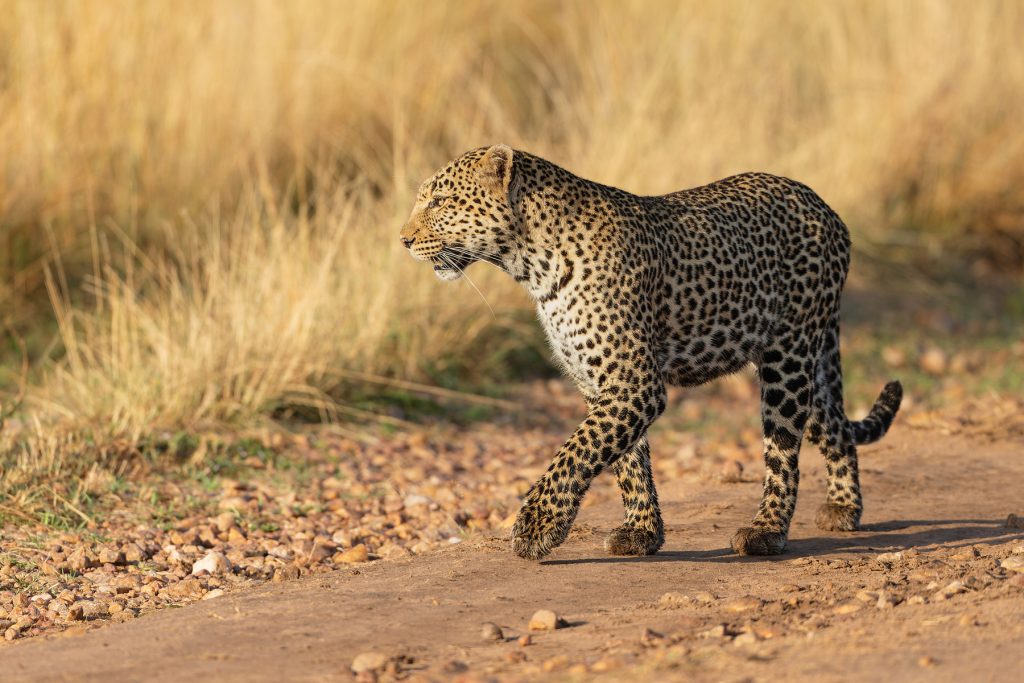
Stunning Leopardess Luluka wanders past our vehicle on the Mara (image by Mike Watson)
We then set off in search of the lion cubs’ father, mighty Olobor, from the Rongai pride. He was slumbering further along the same watercourse but not that nearby, as was his brother Oloshippa. Both looked like they were having a bad hair day after a damp night in the grass and neither showed signs of getting up, so we decided to head off for breakfast. Other mammal photo opportunities this morning included giraffes, buffalo, Olive Baboon, Plains Zebra, Warthog, with two piglets, Topi, Thomson’s Gazelle and Impala. We noted some interesting birds, not all of which were even record shot photographable: Coqui Fancolin, Bare-faced Go-Awaybird, Ring-necked Dove (‘work harder’), African Green Pigeon, African Wattled Lapwing, Grey Kestrel, Rufous-breasted Swallow, Winding and Stout Cisticolas, White-browed Coucal and Arrow-marked Babbler. The breakfast stop is always an opportunity to watch the sky for large birds and this morning’s stop produced flyovers by Marabou, Hooded and Lappet-faced Vultures, Wahlberg’s Eagle and Bateleur! A Secretyarybird was soaring over Entim on our return and numbers of wildebeest were building on the west bank of the river from the camp. This was exciting but, as you know, it did not lead to anything.
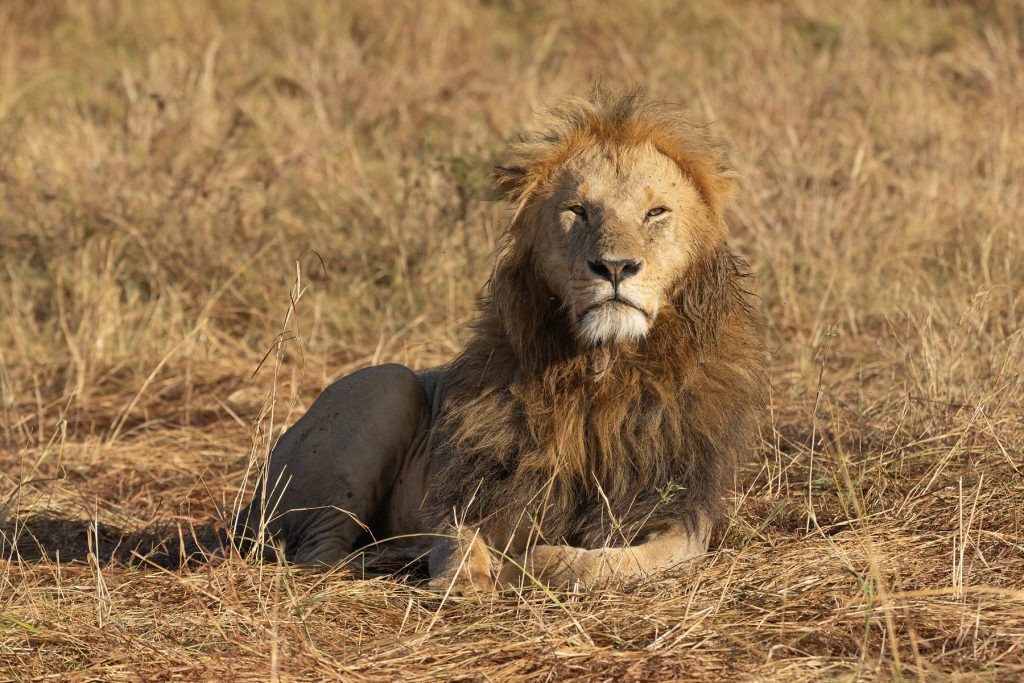
The males of the Mara are known for their impressive manes (image by Mike Watson)
The afternoon drive explored Pose Plains more widely to the east of Entim, where the grass was grazed much shorter than the vicinity of the camp. Grant’s Gazelle (male and female) was new for us here but in rather dull, cloudy light. A herd of elephants passed by quite close, grazing on small leafy shrubs, with a very small baby in tow. We suffered our first punctured tyre, but the boys had it replaced in no time. A White-bellied Bustard flew in while the wheel was being replaced and another was calling a little further on. Within five minutes of the White-bellied, a male Black-bellied Bustard was spotted and we could approach it quite closely, its weird snake like neck was moving almost independently of its body through the long grass. Our first lesson in how difficult it is to photograph anything without at least one million grass stems in the way. On our way back to Entim we swung by a Lioness with two cubs (larger than the early morning cubs) but they were rather inactive, we were getting used to lion general inactivity by now. A final rush back towards camp for a reported rhino sighting was too late to catch a glimpse as it had moved into dense bush so we looked around for a sunset opportunity, finding a lone tree/termite mound/Red-necked Spurfowl silhouete combo as the sun went down. We added Sooty Chat, African Paradise Flycatcher and Yellow-fronted Canary this afternoon as well. The first full day in the Mara ended with hippos and hyaenas calling on the walk back to my tent after evening meal.
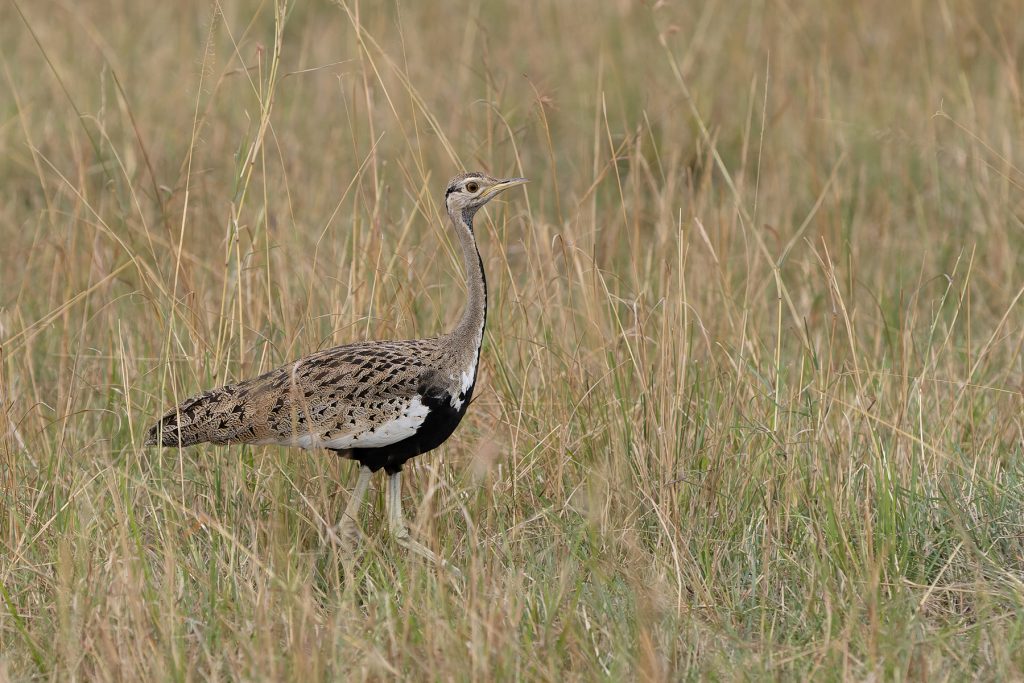
A fine Black-bellied Bustard in the endless sea of grass that is the Maasai Mara (image by Mike Watson)
The following day, and with no news of animals building up near the river, it was time to see a cheetah! You usually need to go off the beaten track to see one, up on the plains to the northeast of Entim and we were totally delighted to meet Nashipai, the most beautiful cat I have ever seen. She was resting in the shade of a small bush on the Kiombo Plains, not far from Kananga Camp. With only one other vehicle we had a very enjoyable start to our encounter with her. Eventually she got up and went for a drink in a small waterhole. We could line her up with some very nice grasses as she strode across the plain. She followed a group of around 100 Thomson’s Gazelles (‘Tommies’) for some time, pausing every now and then, maybe thinking about her strategy to get within launch mode range. We constantly tried to anticipate where a chase might take her, anywhere up to 200m from where she was now. All of this proved futile, but it was lovely to be able to watch her at leisure like this. That is until the sheer number of safari vehicles had built up and we decided to go to breakfast. Just as we passed her we noticed that she had found herself within about 10 metres of a female Impala, which was looking in the wrong direction at the vehicles. She simply pounced on it and gripped it to death by the throat. A rather weird climax to the encounter. A corral of vehicles quickly circled her so it was impossible to get a wider shot of her in the landscape, only zoomed in close ups would do. She spent ages with it tightly gripped in her jaws, panting through her nose for breath until the poor impalas tongue turned blue and its eyes glazed over. Nashipai then got up and dragged it back under a bush. We had only seen the pounce itself from the moving vehicle as our driver spun us round into position but we got a lot of the immediate aftermath. Wow! That was something.
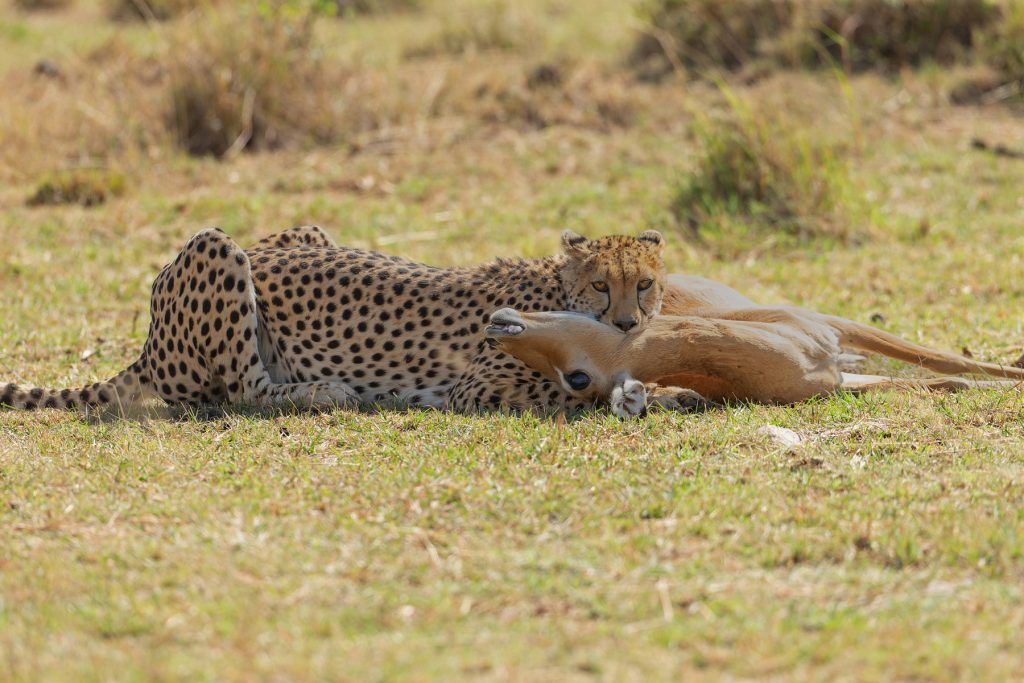
This encounter was much more pleasant before everyone else turned up. After catching her own breath, Nashipai drags the Impala under a bush to eat it. We pushed off after this having already spent a couple of hours with Nashipai (image by Mike Watson)
Not far away we caught up with the two remaining members of the famous five male Cheetah coalition, the ‘Tano Bora’ (= First Five). They were the last two now and looked a little worse for wear, a couple of old moggies close up. Nowhere near as stunning as lovely Nashipai! They were sleeping under bushes by a very small quarry but showed no signs of moving and it was now time for breakfast. The story of the missing three cheetahs of the Tano Bora went something like this. They were from three different litters, and the first to die had left the coalition to mate with a female but was killed by the other four when he tried to rejoin them. The next was killed in a fight with lions and the third to die was allegedly (illegally) killed with a spear by a farmer. So now they are the ‘Last Two’. On our way to Nashipai we had seen a couple of female Lions patrolling the Kananga watercourse, almost coming into contact with a stray hippo that was also wandering through the bushes and while watching Nashipai a troop of around 15 Banded Mongoose tumbled by.
A couple each of White-bellied and Black-bellied Bustards were trackside and three Three-banded Plovers were seen. Other birds included Marabou (2 soaring over Kiombo), Secretarybird (1 hunting from the breakfast stop – under a tree on the Kiombo Plains but it was lost to sight), White-backed Vulture (18 rising from their roost at Kananga as the sun rose in the sky), Bateleur (4), Tawny Eagle (2, including an adult on a nest), White-headed Saw-wing at the breakfast stop, Black Saw-wing, Brown-throated Martin, Lesser-striped Swallow, Mosque Swallow, Wattled Starling and Rosy-throated Longclaw. What a great morning that was!
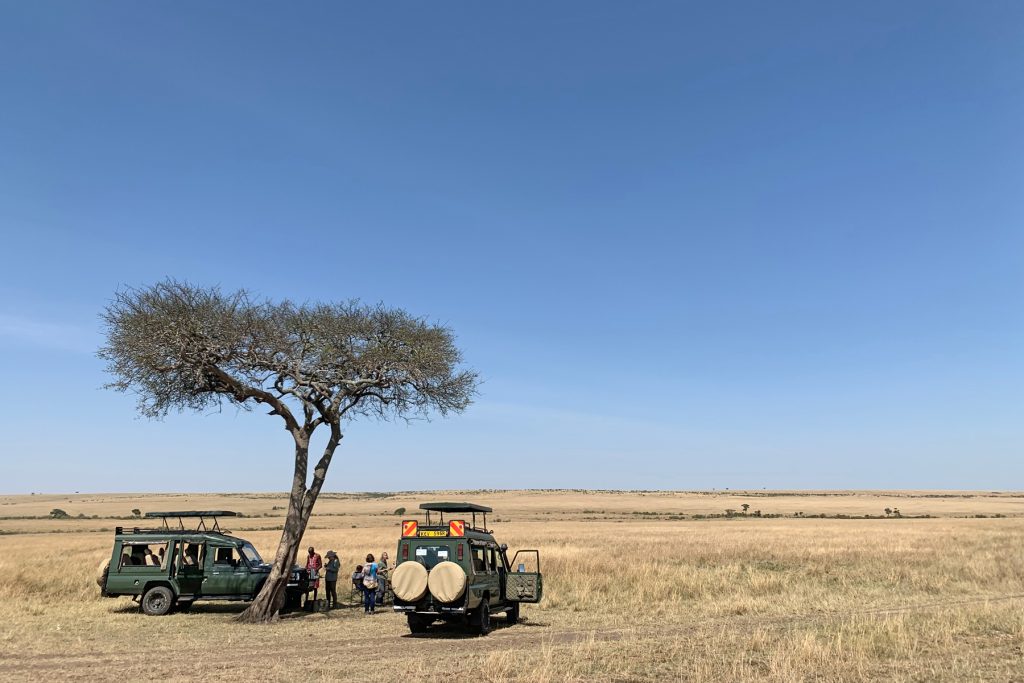
Another bush breakfast stop on the Mara, we enjoyed a different spot each day (image by Mike Watson)
The afternoon safari started off with a series of good photo opportunities. We watched some warthogs feeding on their knees, had three Coke’s Hartebeest at Ashnil, a Lappet-faced Vulture perched overlooking a rather scenic background there, a mother Spotted Hyaena nursing three cubs at a den not much further on, a troop of 10 Olive Baboons, a Black-backed Jackal and a couple of Eland against a wide landscape, with layers of grass stretching away into the distance. Then things kicked off rather. We got news of a build-up of animals at Lookout Crossing, a potential crossing site. We raced there only to find that all the best spots were taken and as a group of zebras crossed. Getting into position can be very tricky indeed. Looking into the hazy light of the west bank where the zebras had gone it become clear that a huge male Leopard had grabbed and killed a foal on the far bank. He was in the grass not far away from the corpse. The biggest and baddest leopard I have ever seen with a huge bull-neck, like a Jaguar, he was a real beast. He went down to the water’s edge to drink later, I didn’t think about it until a few days later, but that’s a very risky thing to do at this spot! There were hundreds of wildebeest also thinking about crossing but nothing more came of it. The belligerent bellowing hippos, the leopard and the thought of lurking crocs probably put paid to any further action. We heard there was a second Leopard on the near bank this time! We didn’t see him until after sunset when he set off walking casually across the grassland, followed by the much fewer safari vehicles still hanging around. We got some great images of him walking towards us in the grass, by anticipating spots he might cross that were quite free of grass stems. There was a pair of Spur-winged Lapwing and two Marabous also at Lookout.
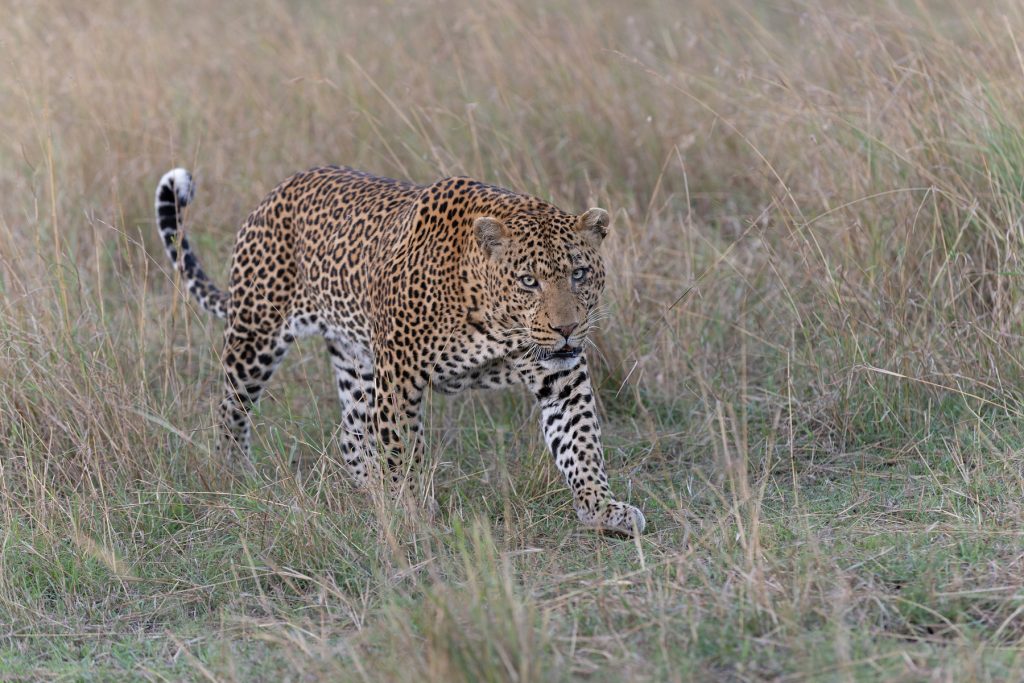
One of the big, bad male Leopards crossing open grassland near Lookout Crossing (image by Mike Watson)
We usually started our mornings with some exploration of our ‘local patch’ and one day we found a Leopard on the prowl at Ashnil, however, it was determined to remain in deep cover where we were unable to follow, even in our go-everywhere Land Cruiser. We then returned to the scene of yesterday’s crime, Lookout Crossing, in the hope that some of the animals in the area the previous day would think about crossing again, but ultimately there was no actual crossing. However, there was plenty to keep us interested and point our cameras at. A young Martial Eagle perched on prominent dead snags along the river and gave us a decent fly past. Marabou storks also gave themselves up today for the cameras, perched in a tree at Lookout and joining a throng of vultures at a wildebeest kill, which had been reduced to bones (skull, spine and rib cage) by the time we arrived. The vultures comprised of 48 Rüppell’s Griffons, around 10 White-backed, four Hooded and three huge Lappet-faced. There were some nice backlit photo opportunities here as well as portraits down to only a few metres from the vehicles at times. Up to five Spotted Hyaenas were dominant at the kill. I was interested to learn that as well as the ‘Big 5’, there is an ‘Ugly 5’ – Marabou, Spotted Hyaena, Warthog, Wildebeest and Lappet-faced Vulture. A couple of warthogs lived up to this billing by eating the partly digested contents of the wildebeest’s stomach.
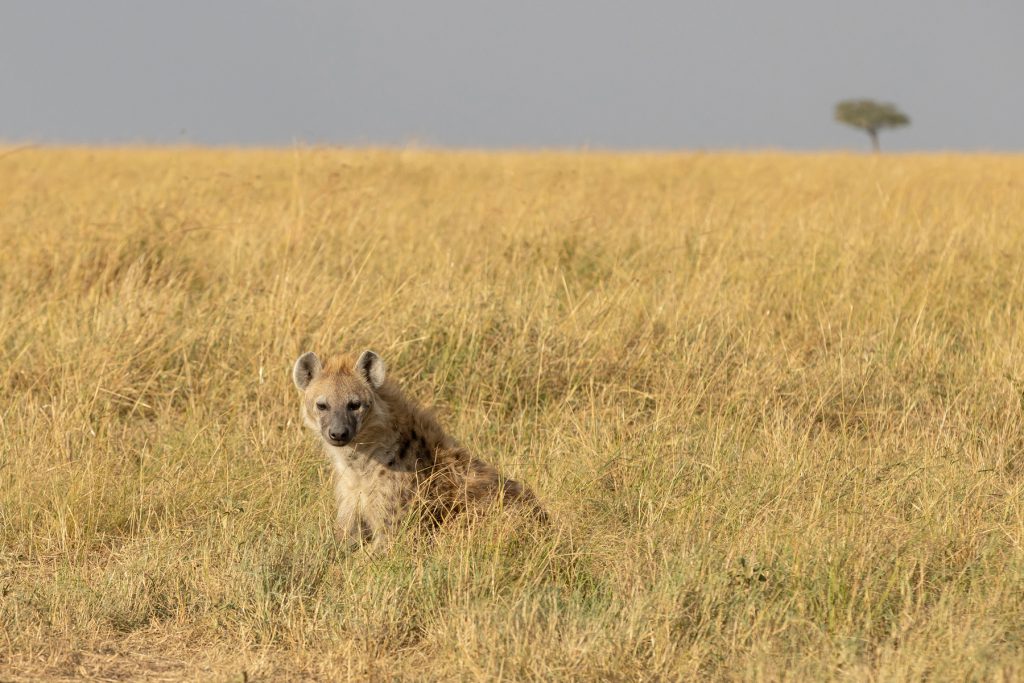
Mother Spotted Hyaena near its den (image by Mike Watson)
The brutish male Leopard was still on the opposite bank of the river, having moved his zebra kill into deeper cover in a gully. A female Lion was slumbering on the riverbank, it would have been out of sight of anyone standing on the top of the bank, another reminder to be careful when selecting breakfast spots! We added some birds in the form of Kittlitz’s Plover and a Bateleur flew over at breakfast. The zebra numbers built up in the Lookout area and we remained hopeful something would happen but after a few inspections they continued to abort their mission, when a stallion would return up the riverbank braying. The hippos did not help either, bellowing whenever the zebras got to the water’s edge. The crossings would all have been east to the west so going away from us and therefore not ideal photographically.
We also saw a very sinister side to hippo life today, something our drivers had never seen before! One large hippo was chewing on a wildebeest carcass, closely following by a younger hippo who was trying to get in on the action. Every now and again the poor wildebeest’s head or feet would appear in the hippos jaws. We did not know how the wildebeest died or whether or not the hippo ultimately ate any of it, but it was certainly intent on hanging on to the poor dead creature. Our guides told us it was the lone wildebeest calf we had seen trotting towards the river alone earlier in the morning. It didn’t stand a chance.
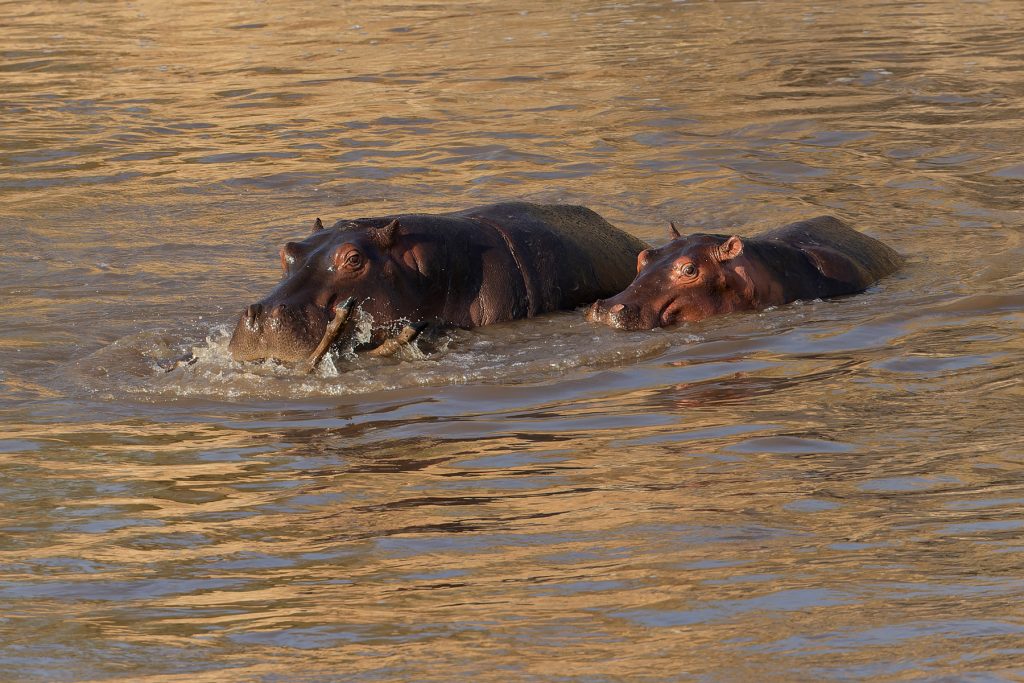
A hippo chews on a dead young wildebeest in the Mara river. We don’t know if it killed the animal nor whether or not it was eating it but it was a first for our very experienced guides (image by Mike Watson)
Our safari that afternoon took us back to Ashnil, just in case there was a crossing development, however, dark clouds were building and looked solid. The light became atrocious as the afternoon went on and ultimately rain set in from around 4PM. We narrowly missed Black Rhino again but a few reasonable encounters, including a male Defassa Waterbuck on the grassland, a couple of young male Lions southeast of the camp and a female Leopard walking through rather dense bush into which the rhino had disappeared. That was our third leopard today, 6th in total of 5 different animals. Pretty impressive in four days. A couple of rather shy male buffalos and 10 Banded Mongoose were seen in addition to the usual commoner mammals. The highlight this afternoon was the mother hyaena nursing 2 pups next to her den, she was in a very photogenic spot albeit not as pretty an animal as the female on day 1. The session was rained off soon after we saw a couple of very close Coqui Francolins and a Black-bellied Bustard was the only other sighting of note on our way home.
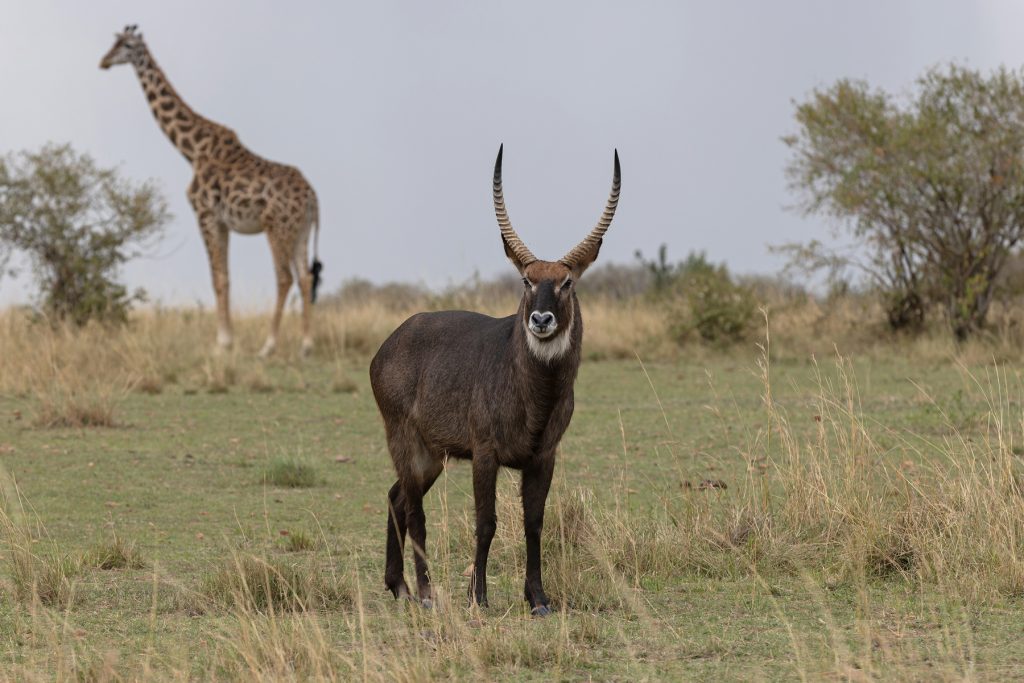
An impressive Defassa Waterbuck on the Mara near Entim Camp (image by Mike Watson)
The next day, the sun began to shine after the previous day’s deluge and we headed out onto the very open plains of Magiyafisi in search of adult male lions. Our vehicles split up in our search effort and we detoured quickly for a sighting of Nashipai, who had been spotted stalking a Thomson’s Gazelle. There were only a couple of other safari vehicles present and we set up ‘down-chase’ of the cheetah and her target. She was around 15km from where we had seen her two days before and she was hunting again. We guessed she must have been disturbed from her Impala kill then? The Tommy was relying on three Topi lookouts but they eventually left the scene. A hyaena passed by. Would it spook the gazelle? No. It stayed put. Nashipai visible in the distance trying to keep below the level of the tall grass. Her head appearing every now and again. Things were looking good until another two Tommies arrived on the scene and spooked immediately taking the dumb original animal with them. Game over. Nashipai gave a very half-hearted chase but never got anywhere near her top speed. We did get some very nice images of her walking in slightly shorter grass than the previous encounter, with uncluttered backgrounds and she is the most elegant of all animals on the Mara after all so any time spent with her is a privilege. A pair of Secretarybirds hunting in the long grass nearby entertained us for a while. We later saw another pair near Entim and one flew the camp over at lunchtime.
Our other vehicle had found a big male lion, ‘Lokolup’ before they were summoned to the cheetah sighting, so we retraced our tracks and set off to pay him a visit. A nice pair of trackside Yellow-throated Sandgrouse were our best of the tour, they were bombproof. We got to Lokolup to find him almost surrounded by cars, and we had to wait a while for a clear portrait view. Eventually he got up and walked towards a watercourse, and we managed some nice walking images too. We were called away again by our other vehicle, they were having a great morning! Sharp-eyed Jane had spotted a drive-by Serval in the grass at Balloon Crossing. We caught up again and it showed very nicely, hunting in the long grass for around 30 minutes. We could manage some pouncing shots of the super-sleek cat but it was generally very difficult, being obscured most of the time. More vehicles joined us, and made viewing even more difficult so called time on a really great session! Other sightings this morning included a herd of elephants, that we could approach quite closely, including an old bull with an injured leg. Coke’s Hartebeest reached a respectable 15 and there was a massive buffalo herd of over 300 beasts!
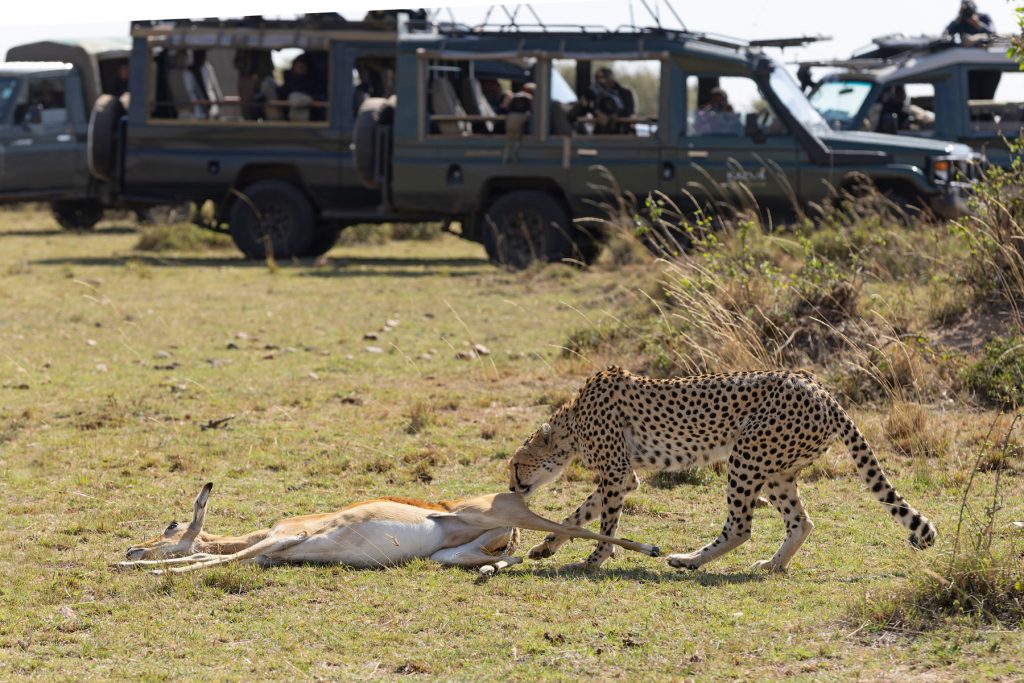
Entim Camp grounds are usually good for birds as well and Orange-breasted Bushshrike and Purple Grenadier put in an appearance at lunchtime. In the afternoon our slow start speeded up very quickly on news of a rhino, our last piece of the Big 5 jigsaw and this time we weren’t too late! It was a very fine-looking young male with a pretty good horn, grazing quietly in the long grass on Ashnil Plains, not far from the river. We got to see why sightings do not last too long as more vehicles arrived, and he wandered off into the dense bush. Other mammals of note this afternoon were Bushbuck (back at the camp on our return), another three sleeping female lions and around 20 Olive Baboons.
That afternoon rather became a birding session with photographic highlights a nice Rufous-bellied Heron in a small marsh (which was steadily drying out) and at least three smart Magpie Shrikes in the bush at Ashnil. Black-headed Heron, Yellow-billed Stork, Bateleur, Tawny Eagle, Yellow-billed Oxpecker, Speckled Mousebird, Zitting Cisticola and Greater Blue-eared and Superb Starlings were also noted. Finally, we enjoyed probably our best one tree sunset on the plains at the end of a very exciting Big 5 day (7 if you include Cheetah and Serval – I had been hoping for these two more than any of the Big 5!).
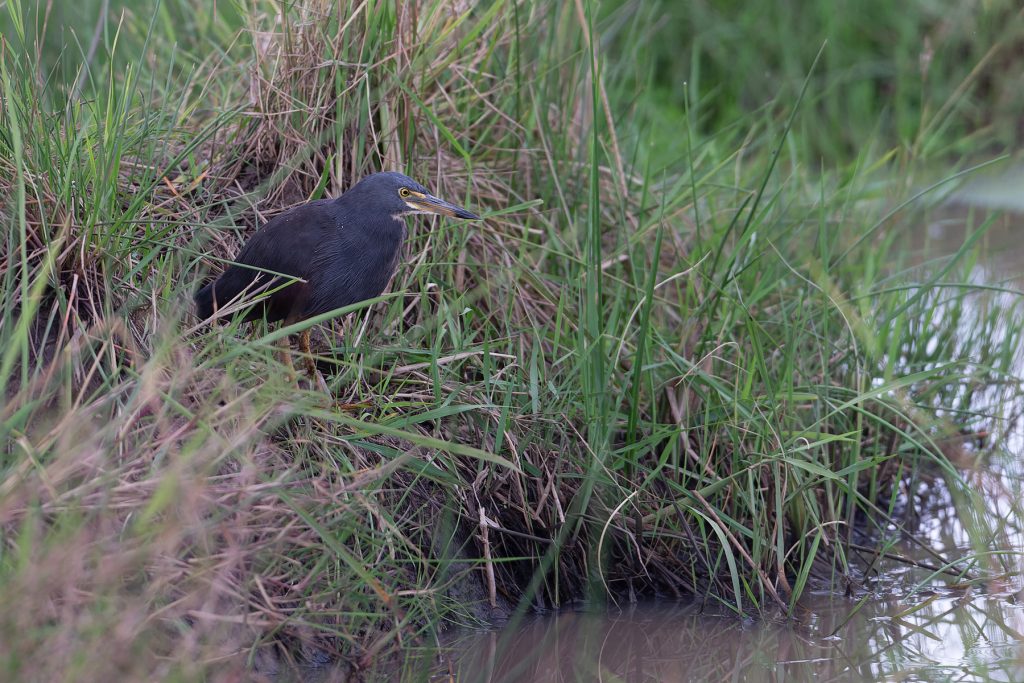
Rufous-bellied Heron, present in small numbers at the rapidly drying marshes (image by Mike Watson)
The Marsh Lions by Jackman, Scott & Scott detailed several years in the life of a pride of lions, whose territory encompassed an area from Musiara Marsh near Governor’s Camp in the northwest of the Mara reserve to the Topi Plain north of Rhino Ridge. Lion dynasties are a constant cycle of prides accepting usurpers who overthrow the dominant male who wins the right to mate with the females. The next morning we headed towards this area, where the current pride that rules the plains here is known as the Topi pride, a massive group of 26 Lions. Our first encounter with them was a little disappointing as they simply passed by on their way to the bushy area on Rhino Ridge, but they kept coming and coming, a very impressive sight. Further north the grass grew shorter with the grazing influence south of xxxx village. We had some great looks at short grass specialist birds including Black-winged Lapwing and a trip of 25 Caspian Plovers, fresh from their breeding grounds in central Asia, a very welcome sight.
There was a very wide variety of birdlife in the Musiara marsh area of Governor’s Camp. The photo highlights were a pair of enormous Saddle-billed Storks, Rufous-bellied Heron, Augur Buzzard, African Golden Oriole and Abyssinian Scimitarbill. Small flocks of African Sacred and Hadeda Ibises and a total of four Hamerkops were seen and a pair of Southern Ground Hornbills flew by. Distracted by a nice herd of Elephants we lost sight of where the ground hornbills went. There were glimpses of other birds here like Hartlaub’s Turaco from our lovely breakfast stop by the Mara River, where Little Bee-eaters delighted, hawking from nearby saplings. Gaudy Baglafecht Weavers were obviously used to the picnic area as they even got into our vehicles looking for food. An African Pied Wagtail sat on its nest on a rock in midstream, gambling on the water level not rising too much. From the same spot there was an idyllic scene of Elephants, giraffes, Hippos and buffalo. No wonder this location has been a popular BBC TV filming location. Other mammals around Musiara Marsh included a gang of 15 Banded Mongoose, hanging around their dead tree hotel. There were several Spotted Hyaenas, zebra, warthogs, topi and waterbuck as well. Back at Entim Camp, the grounds produced a few nice birds too, in the form of Nubian Woodpecker and Tropical Boubou.
An afternoon safari took us up onto the Pose Plains again, as always a happy hunting ground for us. We saw a male Lion next to a days old half-eaten buffalo kill, covered from head to hoof in flies. Yeuch. A gaggle of vultures waited in the surrounding trees. Another couple of sleepy female Lions did not hold our attention for too long. As usual there was a highlight, the ‘Last Two’ Cheetah males were on the move, so we hoped there may be a chase for us to photograph. However, they did not break a sweat and sat down for the rest of the afternoon, in sight of a herd of zebras. They did detour via one of their favourite scenting trees, a very picturesque landscape image. There were some quite nice bird photo opps too, Malachite Kingfisher and Lilac-breasted Roller as flocks of Wattled Starlings were also on the move in late afternoon, flying towards the river, presumably to roost? We finished the session with a decent sunset, complete with ‘god light’.
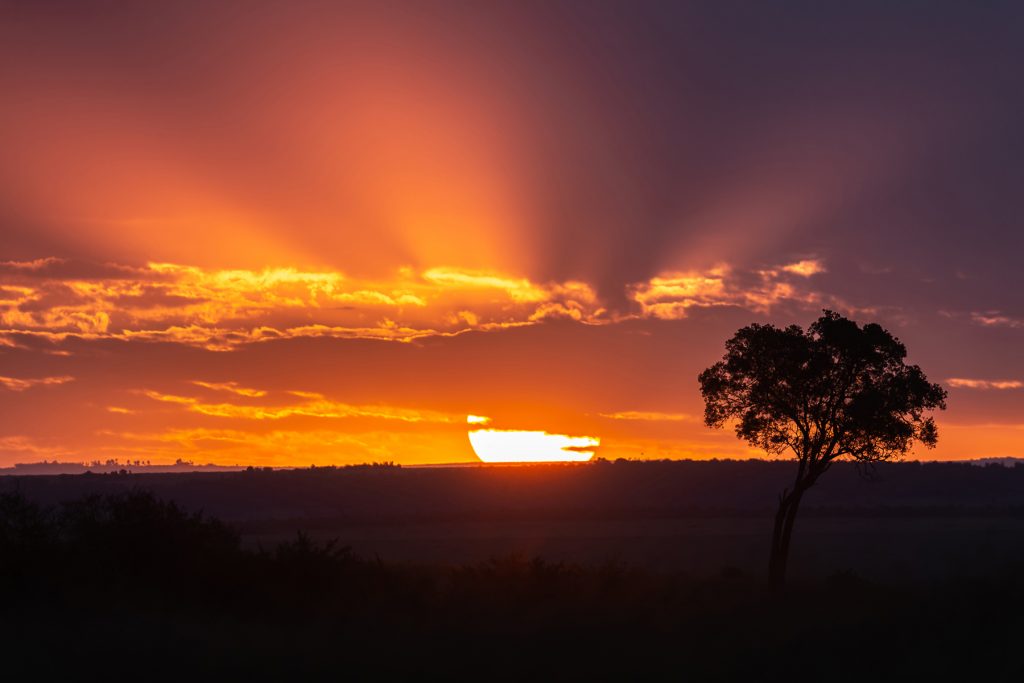
Maasai Mara sunset (image by Mike Watson)
With time ticking away now and still without a crossing we had seen all our other main targets so we started putting all of our chips on the Mara River, cruising around looking for a build-up of animals. We did see some crossing-related action. A poor beleaguered zebra was being shadowed by three hyaenas. It turned and we could see why. Half of one of its flanks was hanging off a large open wound, thought to have been inflicted by a crocodile. Judging from the size of the wound it must have been a big one. Added to that it had a compound break to one of its hind ankles. It was doomed. To cut a long story short it got eaten alive by the hyaenas and then was reduced to a pile of bones by a horde of vultures within a few hours. Not all of our folks wanted to watch its demise, so we left the second vehicle to it and went off to look for something else. We were rewarded with a lovely view of Cavendish’s Dik-dik down by the river. Typically brief. A pair of Grey Crowned Cranes was another very welcome bonus on the opposite side of the Mara at Lookout. Water Thick-knee on the riverbank at Wild-eye Crossing was also new as was a Vervet Monkey family and some nice looks (if that is not a contradiction) at Helmeted Guineafowl. We had a few repeats in the form of Black-bellied Bustard, Yellow-throated Sandgrouse, Spur-winged Lapwing and Black-backed Jackal. Smaller birds that strayed into camera range included Slate-coloured Boubou and White-browed Robin-Chat, also at Lookout. A distant lion kept the lionometer ticking over and another little gang of Banded Mongoose was seen. After lunch we had a short walk in the private wing of Entim Camp, seeing a vision in turquoise, Woodland Kingfisher as well as some duller bird species – Crested Francolin, Grey-headed Sparrow, Speckled Mousebird and Go-away Bird. Violet-backed (or Amethyst) Starling was brighter, but the males did not disgrace themselves for us unfortunately. The afternoon safari quickly became a session photographing the beautiful female Leopard ‘Luluka’ again as she made her way along a streambed, pausing on several mounds. We managed some even better photos of her today. Also of note was a point-blank Wood Sandpiper in a small algae-filled pool by the track – one wonders where the forest bog it spent the summer in was? Red-necked Spurfowl also gave itself up for the cameras this afternoon and we enjoyed a terrific Elephant sunset with a nice band of cloud creating some ‘god light’, followed by some blue hour images taken in the opposite direction. Fab-u-lous! The now familiar evening flight of Wattled Starlings from the plains towards the river took place again.
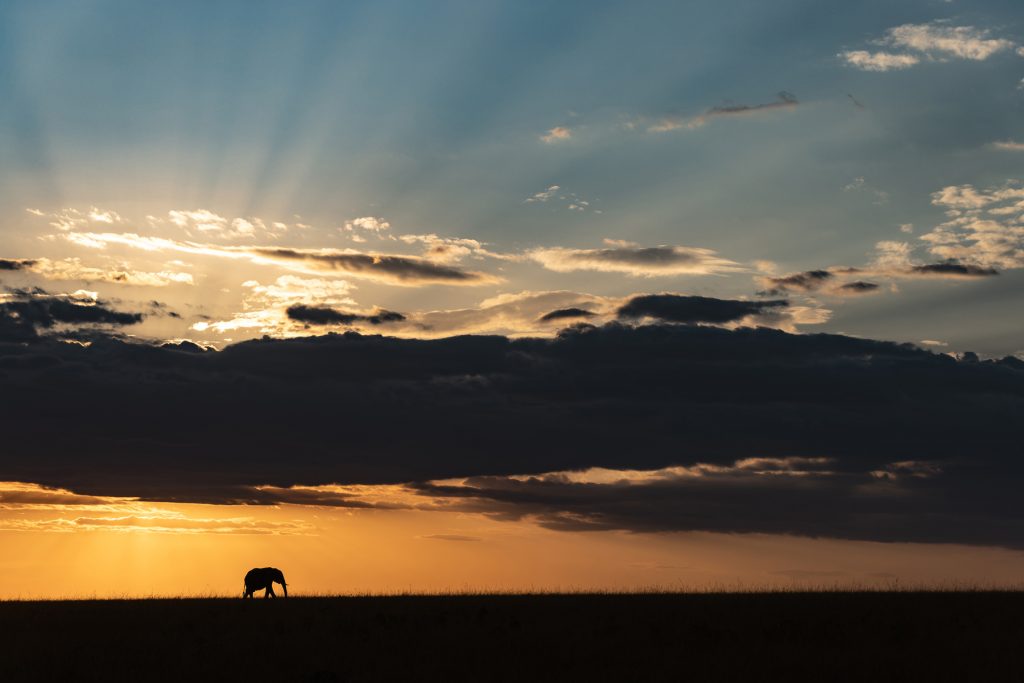
Golden hour Elephant (image by Mike Watson)
Well, the prospect of a crossing was starting to look bleak so we decided to revisit our favourite breakfast spot the following day, the BBC filming location by the Mara River north of Governor’s Camp. We might as well spend our time enjoying ourselves, even if the main reason for our visit to the Mara remained out of reach. It also gave us another chance at a couple of things which had eluded us so far. It transpired to be a very good choice. The Topi pride of Lions was much more co-operative this morning! They were out in force again on Paradise Plain and afforded group action shots and portraits on some large termite mounds before they decided to chase a couple of hippos that had strayed from the river to the small waterholes. One of the hippos made a break for it and managed to slip away, some of the pride giving only a half-hearted chase, but the other chose to stay in the deeper water in the middle of a waterhole, safely far enough from the edge and the young Lions tormenting in. The whole pride gathered here now, it would occasionally bellow at the Lions and make a fake charge to the water’s edge, scattering them before it. Eventually the older Lions all fell asleep, leaving only the naughty youngsters who continued to annoy the three-ton beast. They had apparently eaten a large zebra a couple of days before so were probably not that hungry. They even turned down the chance to hunt a large buffalo that wandered past them, oblivious to their number it seemed. It soon picked up pace when it realised the danger it was in and trotted off. What a fantastic encounter this was – one of the highlights of the tour! Other photo opps followed enroute to Governor’s, a pair of gorgeous Grant’s Gazelles, Black-winged Lapwing (a high count of around 30) and our best Secretarybird of the trip, a pristine adult high stepping through the long grass not far from the airstrip. We flushed a flock of 9 Yellow-throated Sandgrouse at a bush stop and at the BBC breakfast spot a Long-crested Eagle showed up. Little Bee-eater was again very close and photogenic and a pair of Pied Kingfishers was on the riverbank. African Elephant families were in Musiara Marsh, as were waterbuck and several buffalo. Maasai Giraffes were particularly good against a woodland backdrop and we watched as a bull Elephant in musk chased them around, the silly sod. Happily he didn’t come anywhere near us! On the long return to Entim, we had another puncture on Paradise Plains, fortunately with no Lions still around although we did see three young Lions later, closer to Entim itself. In the afternoon we searched the Ashnil area again seeing African Grey Flycatcher and the gaudy Golden-breasted Bunting for the birders, but both were merely record shot material. Lilac-breasted Roller and Helmeted Guineafowl both afforded repeated opportunities before we got some hot news that the private wing folks had a Serval on Pose Plains. We went straight there, took the baton and had it to ourselves for about half an hour in lovely flat afternoon light. Magic! It was another exercise in patience, waiting for a gap in the one million gras stems but we took our best photos by far of this amazing stilt-legged cat this afternoon. We passed it on to our second vehicle, who eventually joined us and we headed off to look for a sunset spot. An African Marsh Owl around 400m away gave some flight views before we left it alone and we managed some nice zebra herd photos before the rather subdued cloudy sunset. So ended yet another incredible day on the Mara. There is nowhere else quite like the East African plains!
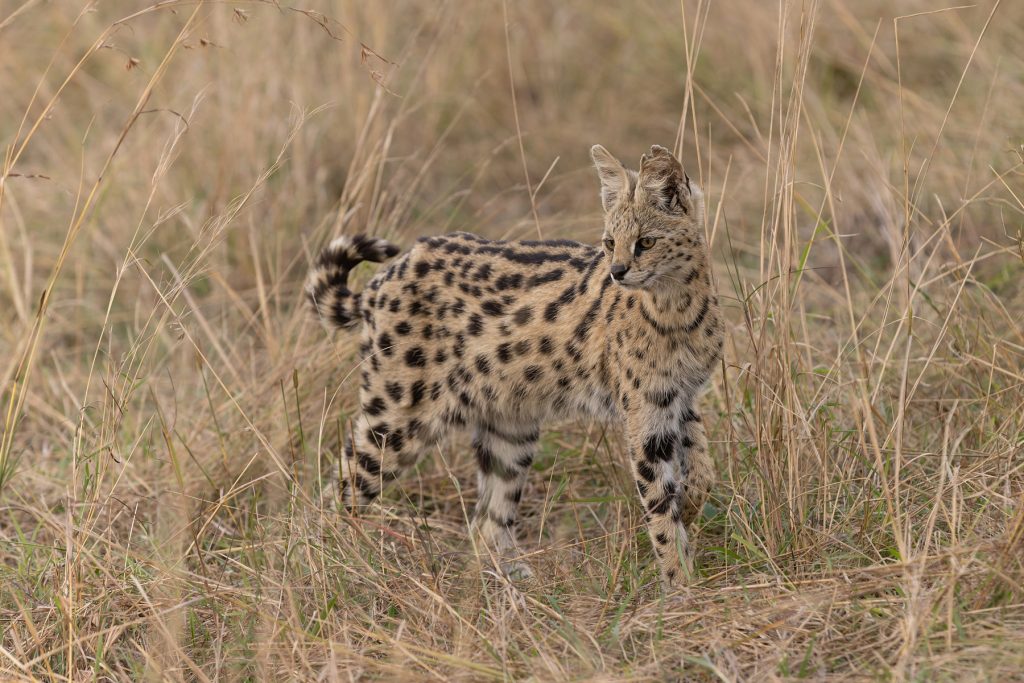
A perfect Serval portrait in nice late afternoon light (image by Mike Watson)
We made some more progress the following day, still no deep water crossing but some very nice encounters. Again, we headed downstream to the crossings beyond Ashnil. There were still two Magpie Shrikes in the bushland at Ashnil and a huge herd of buffalo between there and Lookout, including large bulls, females with calves, belly rubbing on termite mounds and oxpeckers on board. They seemed rather unconcerned as we drove right through the middle of the herd! Strange to be surrounded by so many of the most feared animals in Africa! One of two main highlights this morning was a male Southern Ground Hornbill feeding on the ground among a zebra herd at Lookout. We were able to follow it for ages, constantly catching and eating locusts in the long grass. Another one down the hatch every minute. It was giving its booming call too, sometimes from termite mounds. As always though it was a challenge to photograph it among the one million grass stems. We continued to the southernmost limit of the Mara, the Sand River, with Tanzania on the other bank. I counted 21 different bird species in Tanzania airspace from our delightful breakfast stop by the river, including Lappet-faced Vulture, Tawny Eagle, Augur Buzzard and White-headed Saw-wing of note. After breakfast we noticed a gradual build up wildebeest and zebras on the Tanzania side of the river, they came down to the shallow water, some to drink but then around 200 wildebeest crossed the river, only ankle-deep but at least it was a crossing and quite a picturesque landscape too as they disturbed a pair of Hamerkops. On our return we had a good close encounter with a male ostrich at last on Pose Plains. Back at Entim Camp another walk after lunch produced Go-away Bird, Speckled Mousebird and Woodland Kingfisher again. The afternoon safari produced Maasai Giraffes on the move towards Pose and then a great audience with a couple of big nasty Lions resting in a watercourse there. They were the sons of famous, now deceased, Lion ‘Scarface’ – ‘Mrefu’ (‘Longest one’) and ‘Doadoanose’ (‘Spotted nose’). The light was pretty bad by now, with 100% cloud cover turning into a light drizzle. So, what to do? Wait for a head shake. That worked pretty well. The sky grew darker and the rain heavier so we called time and headed back. A dramatic thunder and lightning storm followed, which we could watch in comfort from the lounge area. The action wasn’t finished yet though, towards the end of evening meal we heard a loud roar, a Lion. Wow! That sounded close. There was some activity with our Maasai camp guards hurrying around and now carrying their long spears. That is always a sign if there is a large animal a little closer than usual. I returned to my tent and the roars continued well into the night, there were apparently a pair of young male lions in the bushes between my tent and the private wing. It was thrilling to listen to, with a background chorus of hippos bellowing and hyaenas whooping in the darkness. The Mara comes to life at night!
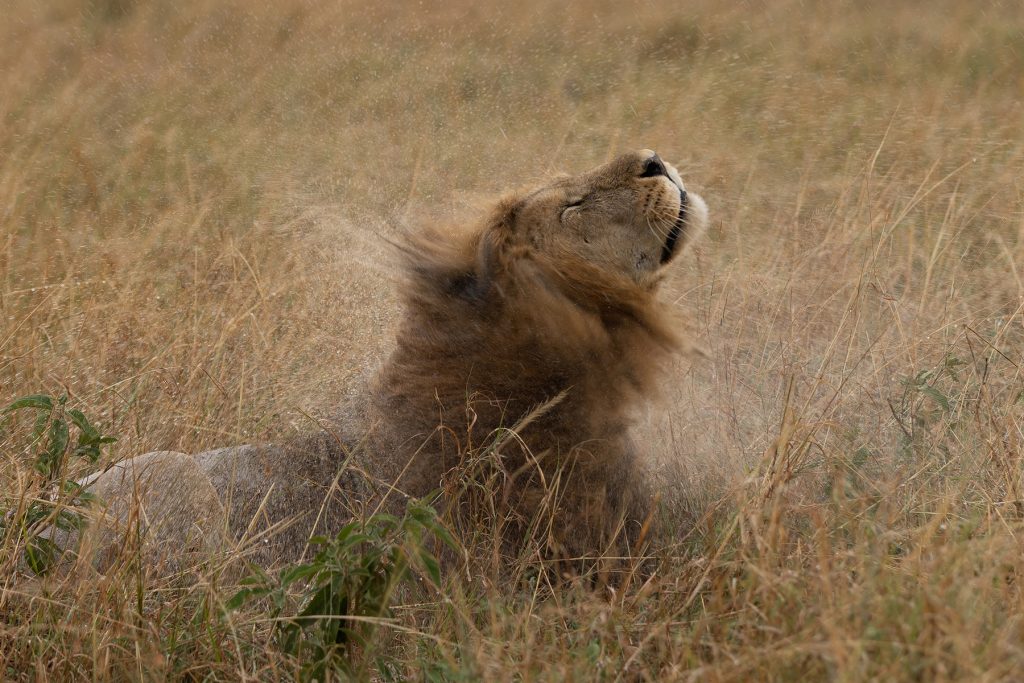
This male Lion is called Mrefu, a son of the famous Scarface. What to do in the rain? Wait for a head shake! (image by Mike Watson)
Our time on the Mara was drawing to a close and on our last full day bwe drove southeast onto the plains above Ashnil and then south towards Lookout. A lone tree sunrise on Olmisingiyoi was nice, and we chanced upon a sleeping Lioness on the open plains. She woke up, yawned and immediately noticed that, unbeknown to both parties, one of the balloon breakfast teams had set up around 100 metres from her. She must have been tired as she allowed four zebras to pass within about 10 metres and they soon trotted away when they noticed her! We took some lovely backlit images of her before we moved on. Black-bellied Bustard, Black-winged Lapwing and Crowned Lapwing all showed well in nice morning light. The zebras on Lookout Hill were also very nice as we made our way to the river. Mammals by the river included all the usual ones, including Black-backed Jackal and Defassa Waterbuck of note. We also witnessed something gruesome. We had spotted a wildebeest apparently swimming, rather treading water near the far bank of the Mara River. This was very odd, they never tarry in the water. As we got closer, it became clear that the reason it wasn’t getting out of the water was that it couldn’t owing to the huge Nile Crocodile that had a vice like grip of its flank. This went on and on, the wildebeest put up a very valiant fight as the crocodile had to loosen its grip every now and again when it had to resurface for air. When this happened, the wildebeest would try to edge closer to the bank but it failed to make enough headway each time and eventually, after almost an hour of struggle another croc slipped into view, bit it across the face and drowned it. The two crocs were seen swimming off into the shadows with the deceased wildebeest in tow. Shame, it was a brave animal. I guess drowning is probably preferable to being eaten alive by the hyaenas waiting beyond the riverbank? The weather was becoming steadily stormier in the afternoons in recent days and today we witnessed another heavy downpour. Not before we managed some close looks at. African Wattled Lapwing at last! We had sped past quite a few already, always with some ‘bigger fish to fry’. Female Leopard ‘Luluka’ was surrounded by vehicles in a ditch, so we declined another opportunity to take a look at her and instead, in a race against time, we just made it to some Lions up on the plains and were able to watch and feel the storm crash into them. One particularly nice Lioness lay on a termite mound, watching the rain approach. The temperature dropped suddenly and then the rain hammered down. Some terrific thunder and lightning ensued, and we made our way along some very slippery jeep tracks. We continued to watch after dark from the shelter of the camp. It was more of a raindowner than sundowner but it was great to recount some of our favourite encounters of our stay at Entim.
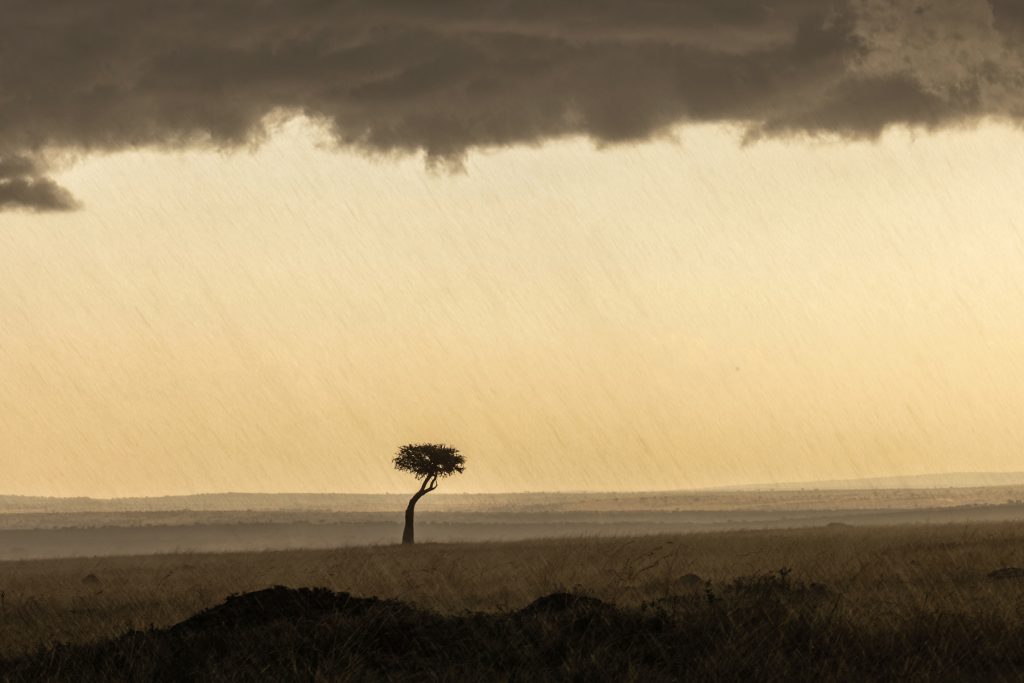
Feeling the full force of a storm on the Maasai Mara (image by Mike Watson)
We said goodbye to Entim Camp and our last safari was the transfer to Olkiombo. The drive was rather uneventful apart from a very tricky crossing at Rekero, which needed all our drivers’ skill. The tracks were slippery after the rain the previous day, so progress was slower than usual, and we only saw a White-bellied Bustard and a Striated Heron of note. By the airstrip itself, four subadult male Lions lingered by the remains of a buffalo kill but were not photogenic, with a gaggle of other vehicles already there. We were happy to make it to the airstrip in time to board the Cessna Caravan 12-seater to Wilson Airport in Nairobi, hand baggage stowed behind the netting in the back of the cabin! We had a great time on the Mara, maybe next time we will get a deep water crossing but the awesome array of African wildlife went a long way to make up for this.
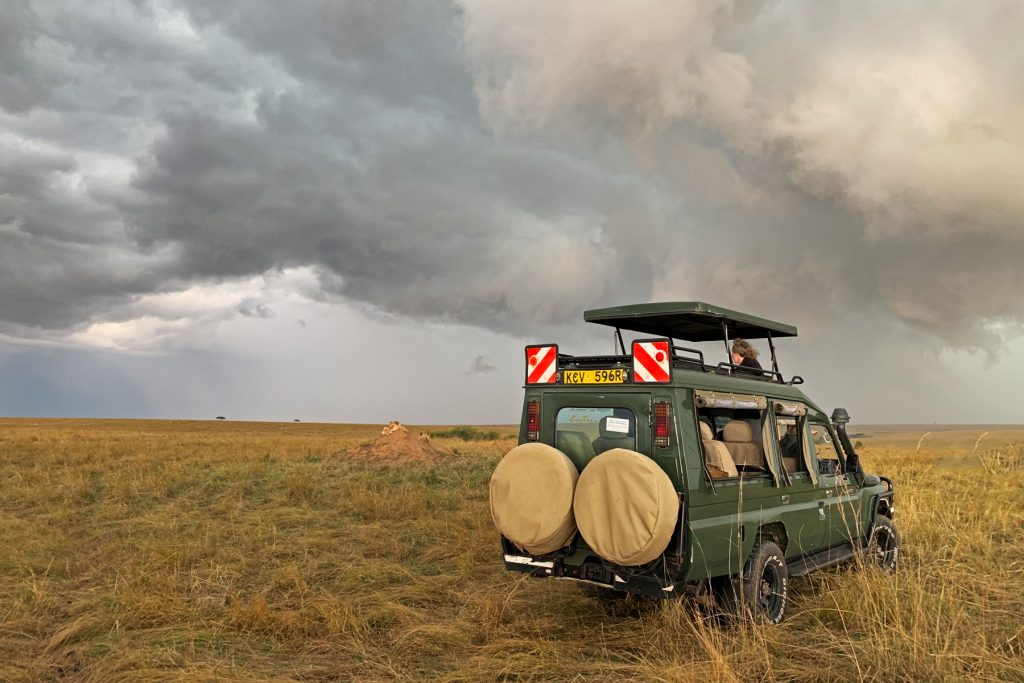
Watching Lions, watching another storm approaching (image by Mike Watson)


















































































































